Chaco Culture – A must visit in New Mexico
This is my ninth post from the state of New Mexico, and I now understand why it is called The Land of Enchantment. In the last post Alison and I visited Tent Rocks National Monument with its amazing hoodoos and slot canyon. In this post we are heading to a place almost as remote as you can get in this huge state, Chaco Culture National Historic Park which is also a UNESCO World Heritage Site. Won’t you join us to find out if the difficulty in getting here is worth the effort?
Where is Chaco Culture National Historic Park?
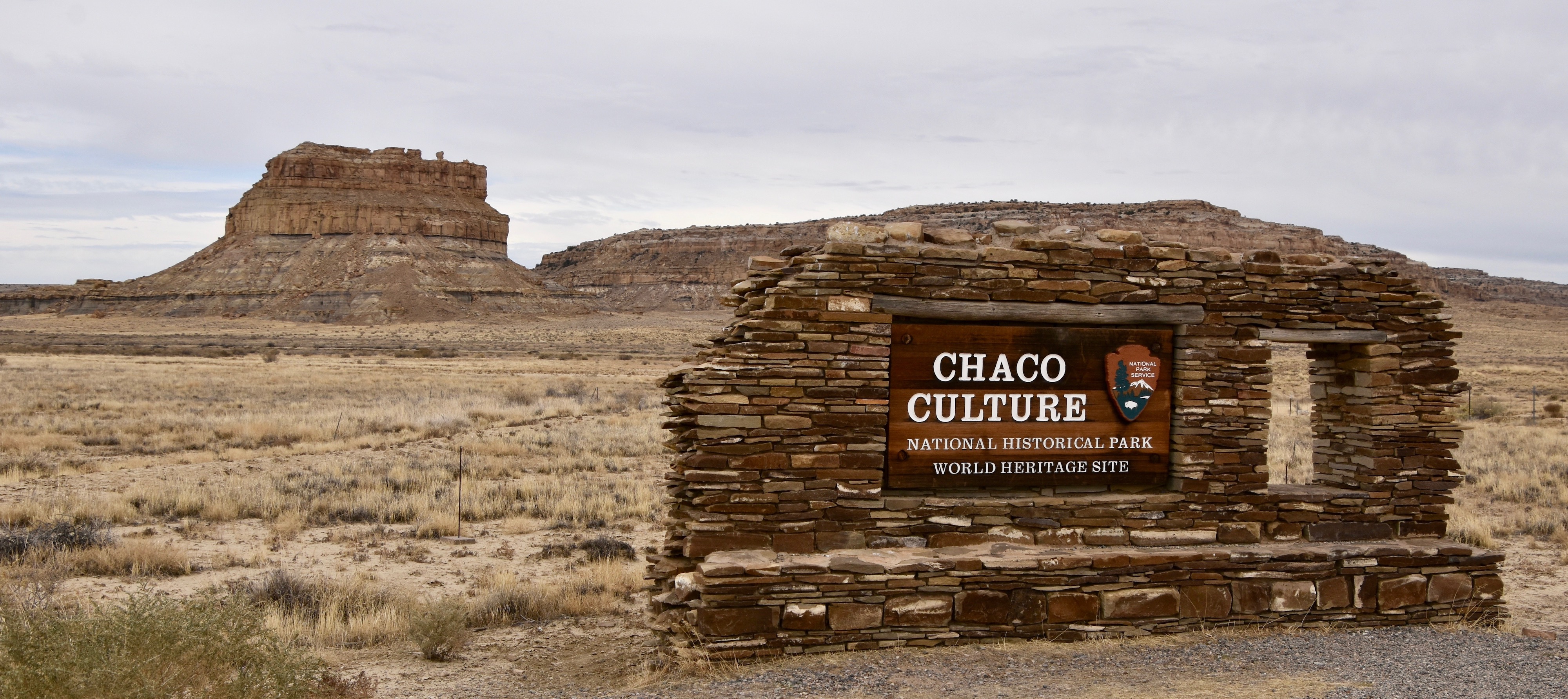
This is a map from the official website showing the location of Chaco Culture N.H.P. lying west of Albuquerque and sort of halfway between Farmington and Gallup.
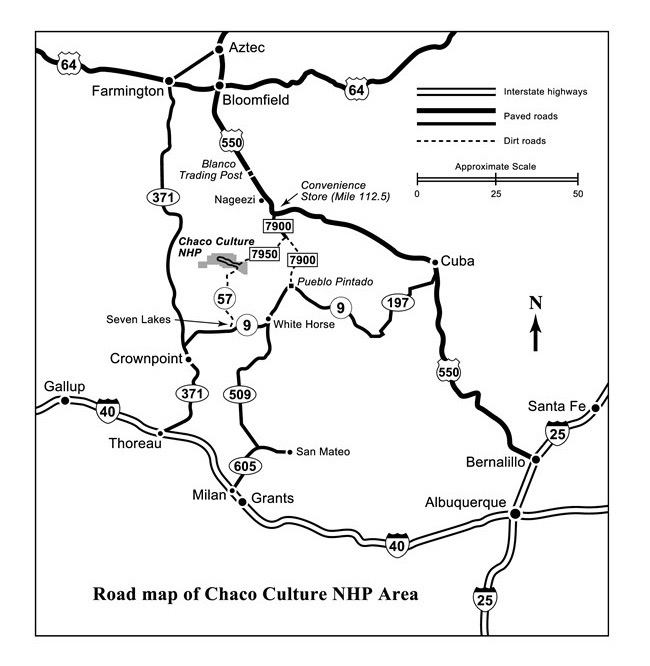
It doesn’t look so remote, but remember, New Mexico is a huge state, the fifth largest in the union at 121,589 sq. miles. Looking at the map you can see that the only roads leading into Chaco Culture are unpaved and looking at the scale you can see the distance from the end of the paved road is about 25 miles (40 kms.) and there are absolutely no services on either of the roads leading in. In fact, there is almost nothing except dry scrub land and the occassional cow or sheep herd. Driving down these roads one can’t help but think, “Who the hell would want to live out here, and if you did, how would you survive?”
The day we visited we came in from the north on county road 7950 which was a fairly good and wide gravel road. Leaving we went south on Route 57 which was a different story. This road was much narrower, had umpteen cattle gates which if you weren’t paying attention could send your vehicle airborne and in places was quite muddy with large ruts. I would not recommend going this route without four wheel drive. Also there is no cell phone coverage and virtually no traffic. We were visiting in early November so it’s probably busier at other times, but if you did break down or get stuck, you might be there for a long time. So when visiting take lots of water and some food supplies.
What Exactly is Chaco Culture?
Before there was ever anything in the area that might be called a human culture, there was the geomorphological process that created the landscape we see today. Everything in this area of New Mexico is the product of sedimentation, which by definition means it had to have once been covered by water. The Cretaceous Period lasted from 145 million years to 65 million years ago when it ended with a bang as a massive meteor crashed into the Yucatan peninsula in Mexico and effectively wiped out the dinosaurs almost overnight. For a part of this time from 80 to 75 million years ago, this area was covered by a primeval sea and huge sea monsters like mosasaurs and plesiosaurs swam where you might be walking today. Their fossils and those of hundreds of other extinct species are regularly found within the area contained within Chaco Culture N.H.S. So even without human intervention, this place is of great interest to paleontologists.
Once the seas dried up, the ocean floor sediments coalesced into many types of sedimentary rocks that are what comprise the landscape of today. Famously known for their various rates of erodability, these rocks in turn morph into the many hued mesas, buttes and cliffs that make the American southwest so fascinating a place to visit. Man arrived on this scene in what in geological time was a mere blink of an eye ago, but in human terms, ancient history. Human settlement in what is usually described as the Chaco Canyon area dates back to 10,000 years ago and there are over 4,000 identified archaeological sites in the area. However, what really makes the Chaco Culture so significant are the settlements that thrived here from the 9th through the 13th century.
The Anasazi people have long fascinated historians, archaeologists and conspiracy theorists. The name is a Navajo word for ‘ancient enemies’, but is more often simply translated as the ‘ancient ones’. At one time it was believed to have been a highly developed civilization that simply vanished for reasons beyond our ken. Today we know from linguistic, dna studies and other modern scientific methods that they were the ancestors of the the Pueblo people who still inhabit much of the southwest, so they never disappeared at all.
This map shows the region inhabited by the Anasazi with Chaco Canyon, Mesa Verde and Canyon de Chelly as the principal archaeological sites.
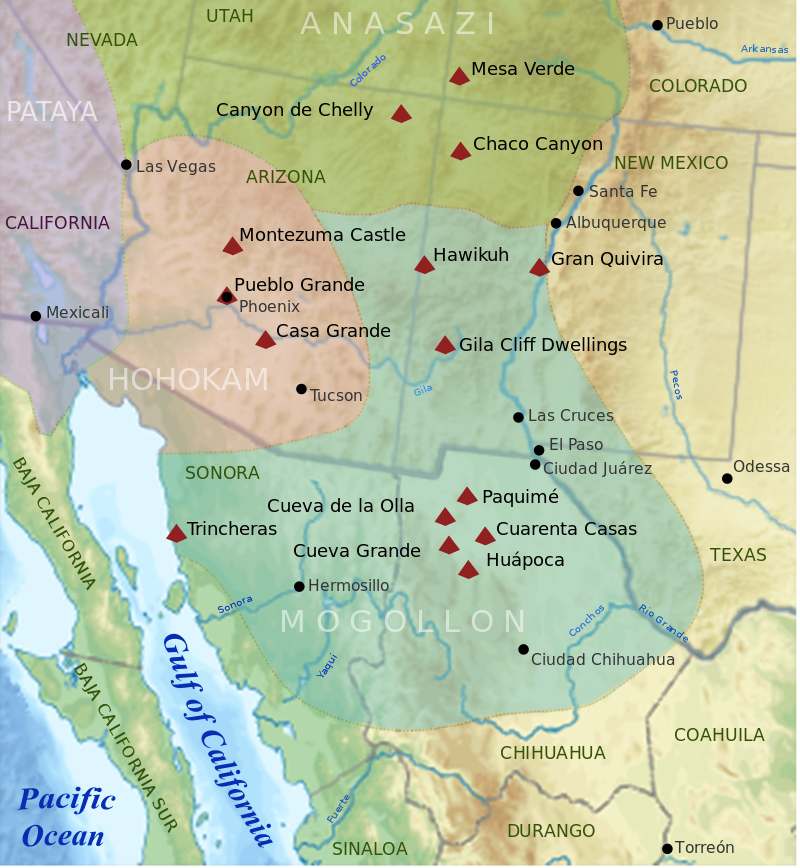
Without doubt, Chaco Canyon was the largest and most important settlement of the Chaco Culture and seems to have been the centre of not only commerce, but also religious ceremony as well. As this next map shows, all roads did not lead to Rome, but rather in this area to Chaco Canyon.
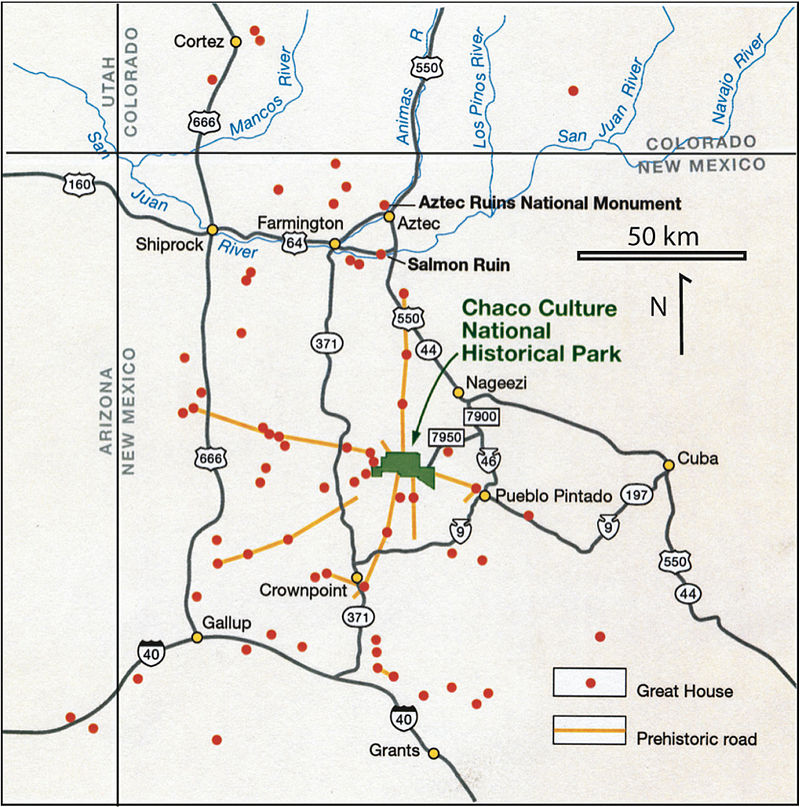
The ‘great houses’ of Chaco Canyon constitute quite simply the largest and best preserved archaeological site in all of United States and Canada. You have to go all the way south to the great Mexican empires to find anything larger or more complex.
This is the description of the importance of Chaco Culture as contained on the UNESCO World Heritage website:
For over 2,000 years, Pueblo peoples occupied a vast region of the south-western United States. Chaco Canyon, a major centre of ancestral Pueblo culture between 850 and 1250, was a focus for ceremonials, trade and political activity for the prehistoric Four Corners area. Chaco is remarkable for its monumental public and ceremonial buildings and its distinctive architecture – it has an ancient urban ceremonial centre that is unlike anything constructed before or since.
What makes the study of the Anasazi so fascinating is the riddle of why, around 1250 they seemed to have abandoned the great houses and moved into cliff dwellings and then after that simply left their traditional homeland and migrated south. Over the years many explanations have been proferred, usually citing the same reasons given for the Mayans abandoning their great cities, many along the same time line. For an in depth discussion read this excellent article, Riddles of the Anasazi by David Roberts in the Smithsonian Magazine.
Chaco Canyon and the Chaco Culture was first brought to the Western World’s attention by governor José Vizcarra when it was still part of Mexico and it has been fascinating visitors ever since. In 1907 it was designated as a National Monument and in 1980 upgraded to a National Historic Park. It received its UNESCO World Heritage Site designation in 1987.
Visiting Chaco Culture N.H.P.
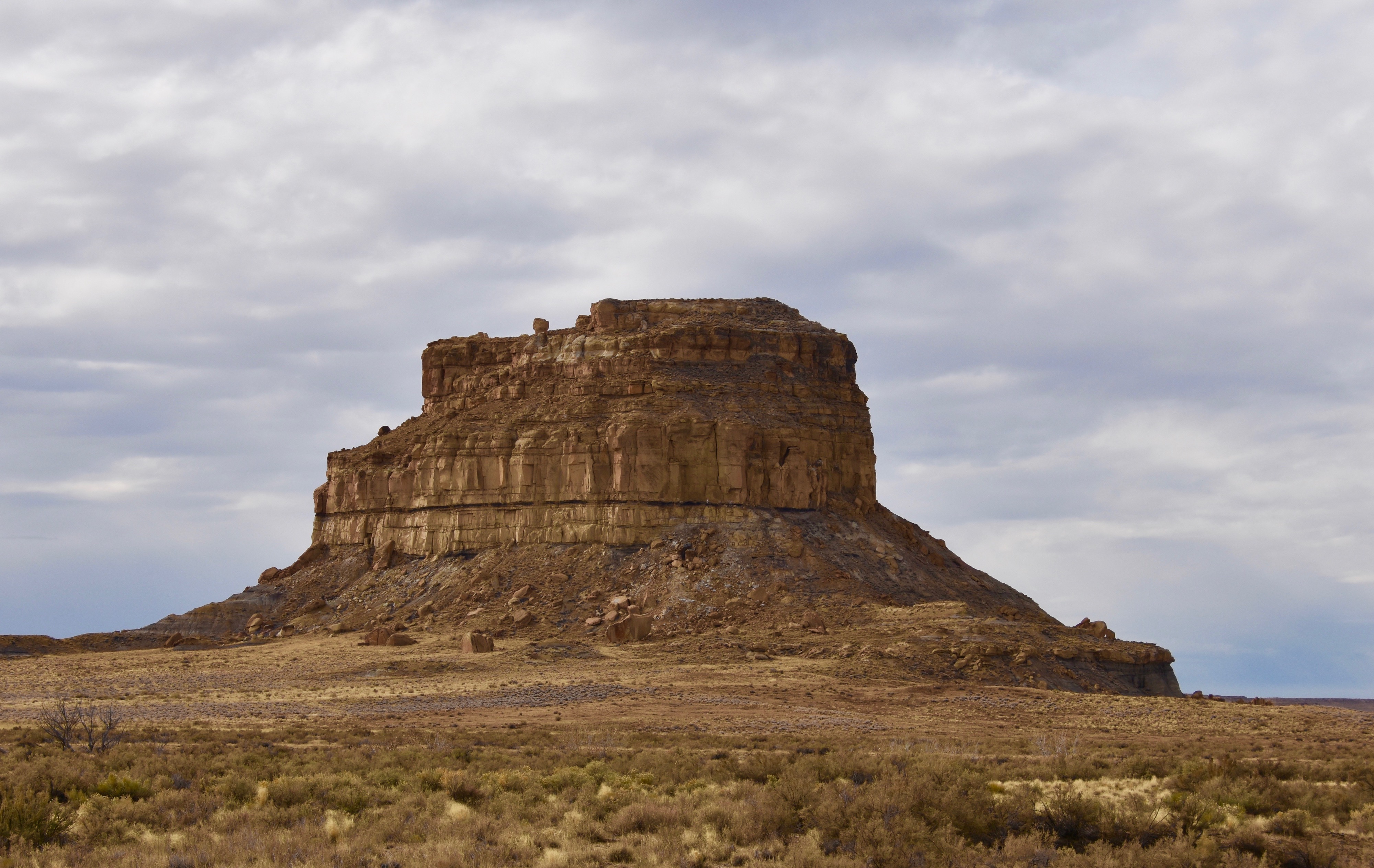
Regardless of which way you approach Chaco Culture N.H.P. the first thing you are goung to see it Fajada Butte which is no ordinary chunk of rock, but a sacred site that is off limites to climbers. At one point their was a man made ramp that made it easier to get to the top where various carvings and rock formation combine to create the ‘sun dagger’ that accurately predicts the summer solstice. Like the Mayans and other more southern Indigenous peoples, the Anasazi were expert astronomers. I you are fortunate enough to get one of the few camp sites within the park you will get a chance to observe the night sky much as the Anasazi did as it has been designated as an International Dark Sky Park. There is a small observatory near the Visitor Centre that offers weekend viewing programs from April to October.
This is a map of Chaco Culture N.H.P. which begins with the Visitor Centre which you will arrive at first regardless if you come in from the north or south. You stop here to pay the entrance fee, pick up brochures and view the excellent small museum. For a small fee can also purchase specfic brochures on many of the pueblos you can visit and I highly recommend doing that for at least Pueblo Bonito.
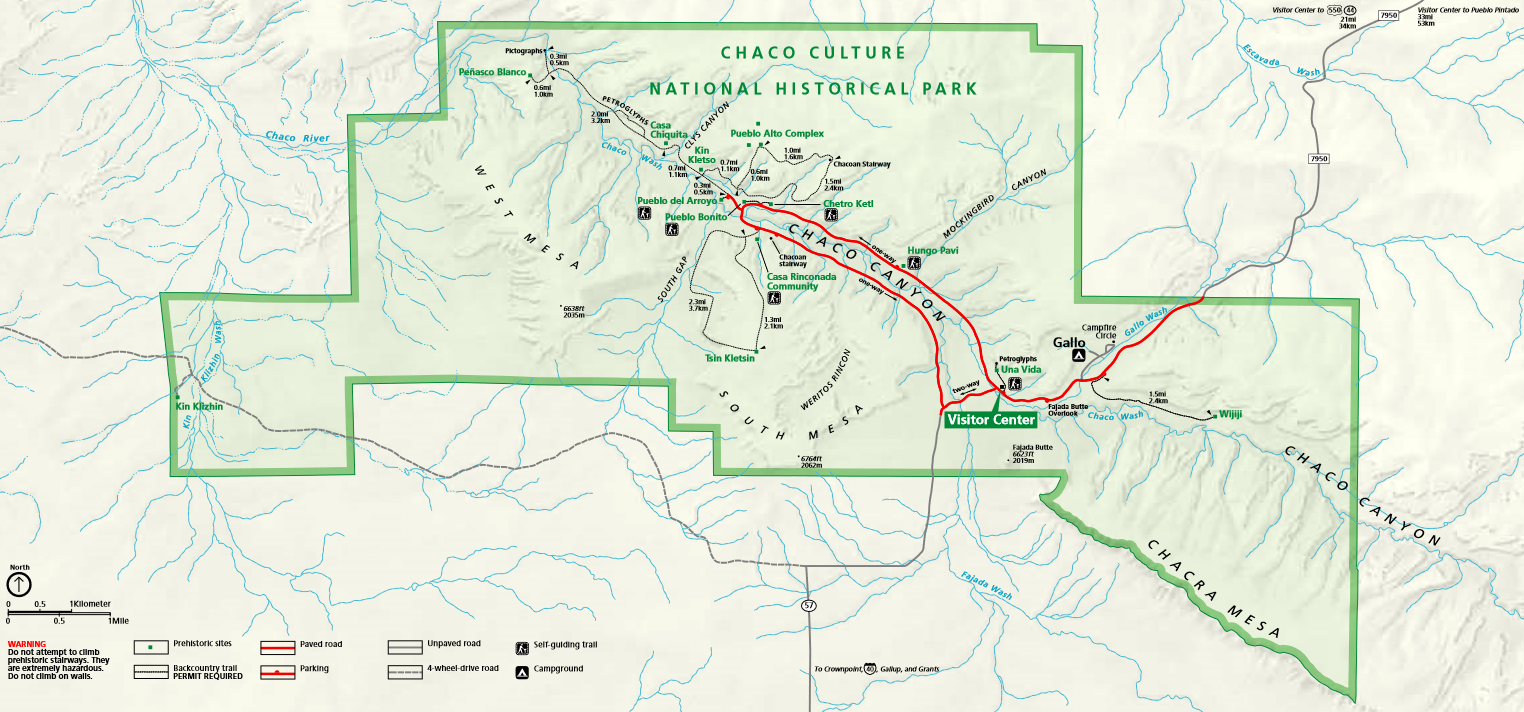
This is the Visitor Centre.
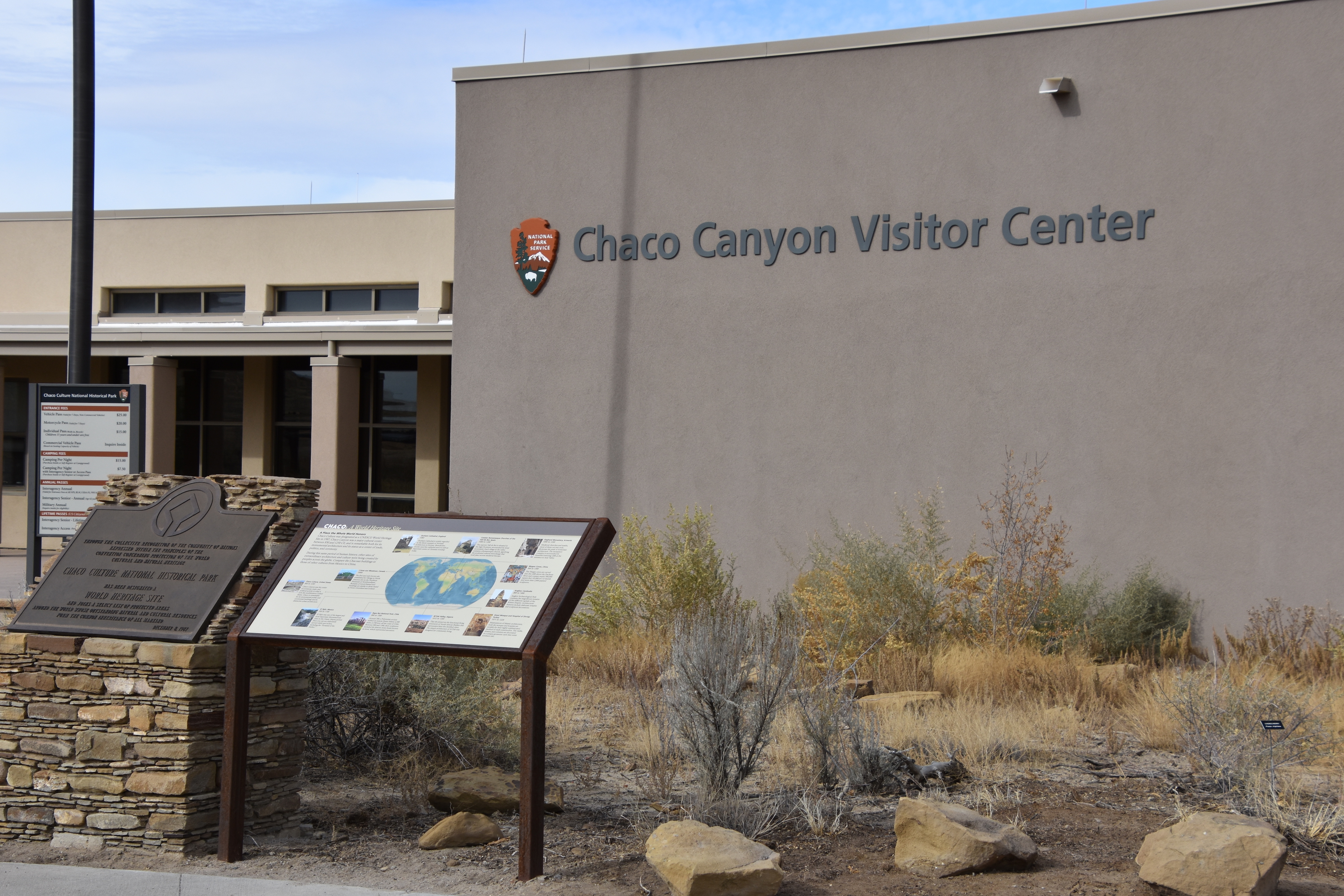
Outside there is the usual UNESCO information you find at most World Heritage Sites and this very interesting interpretive panel which shows contemporary events occuring around the world at other World Heritage Sites at the same time that people of the Chaco Culture were flourishing here. Some of the most interesting noted are the Viking settlement at L’Anse aux Meadows in my country of Canada, the stone heads or moai of Rapa Nui (Easter Island), the building of Durham Cathedral in England and the grand temples at Angkor Wat in Cambodia.
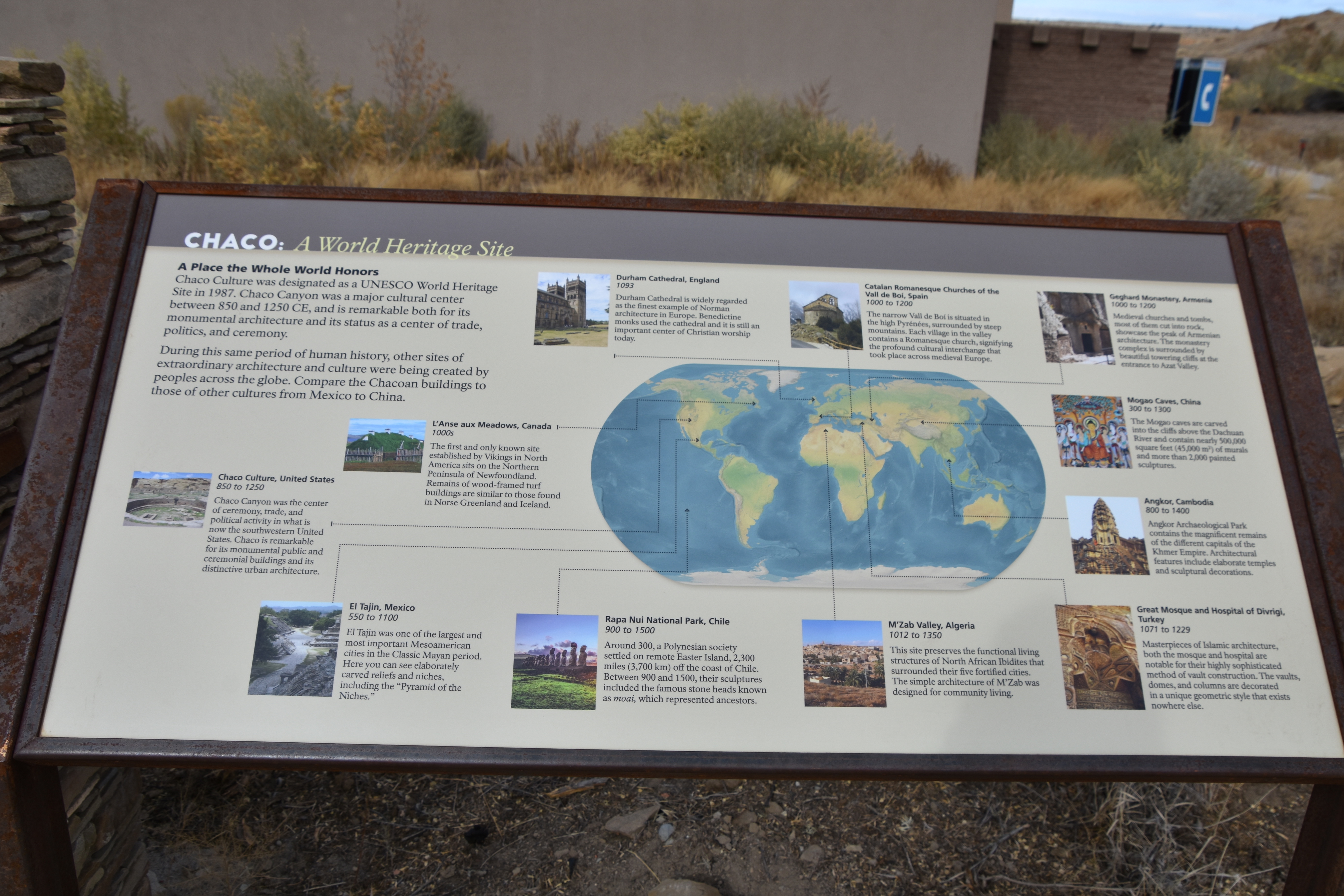
Inside the Visitor Center there is a model of Chaco Canyon which is very helpful in orienting yourself because unlike several of the other Indigenous sites we have visited in New Mexico including Bandelier National Monument and Gila Cliff Dwellings National Mounment,you don’t get the feeling you are in a canyon. That might seem nonsensical given this representation that clearly shows that you are, but the distance between the canyon walls is actually quite far so you don’t get that enclosed feeling that you might expect.
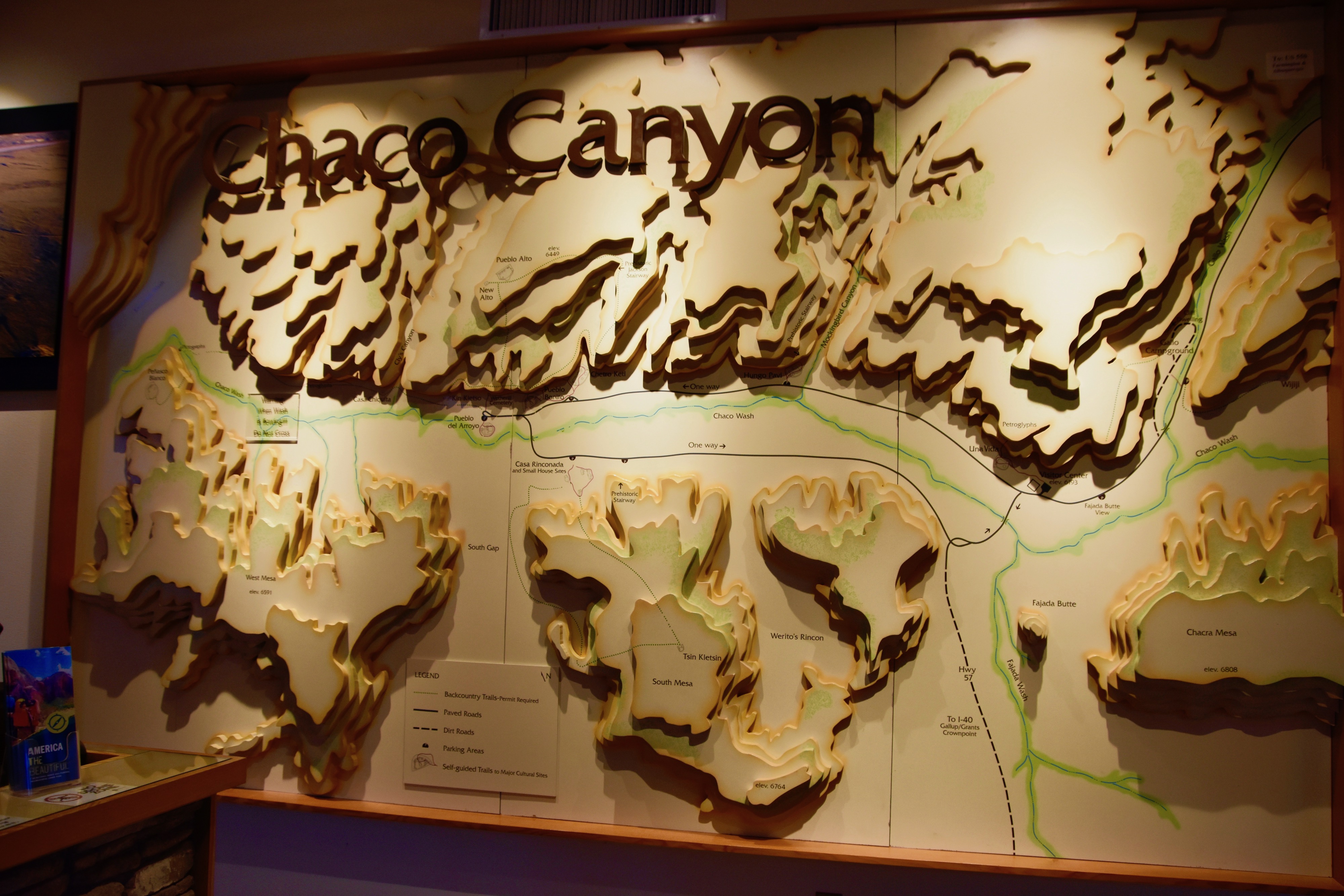
Also at the Visitor Center is a model of Pueblo Bonito which is the highlight of most visits to Chaco Culture as we shall see when we get there.
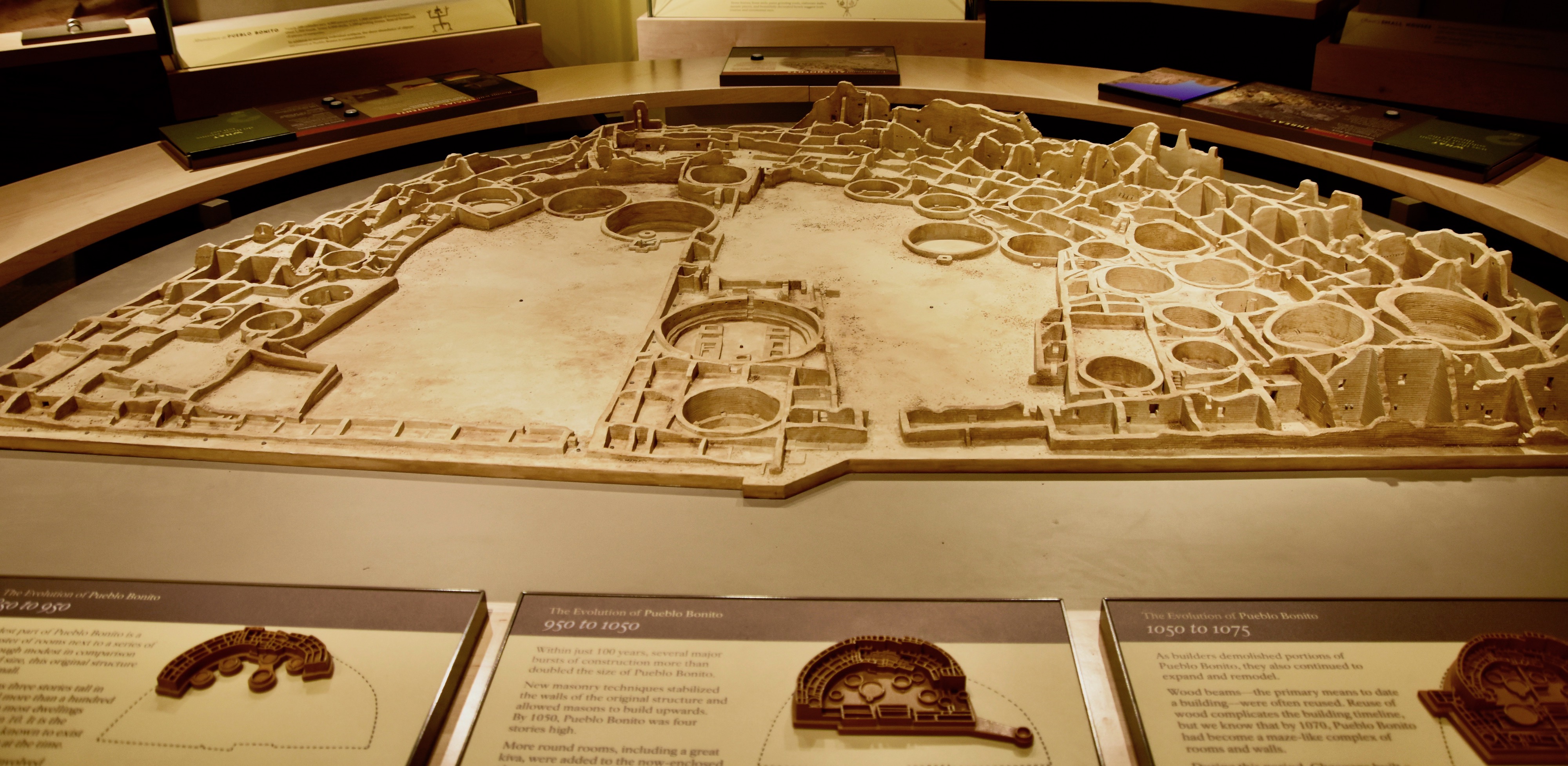
The large model shows Pueblo Bonito as it looks today with smaller ones surrounding it showing what it looked like at its various stages of development. If I told you that hundreds of years before the first European ever set foot in North America that there was a building comparable in size to the Colosseum of Rome here, you would probably wonder what I was smoking. But yes, Pueblo Bonito once stood five stories tall and contained over 650 rooms (some sources say over 800) and while not quite as big as the Colosseum, wasn’t that far off.
This is a wall showing the insignia of the twenty-six Indigenous groups from many states that still consider Chaco Canyon sacred ground and return here to perform ritual ceremonies on a regular basis.
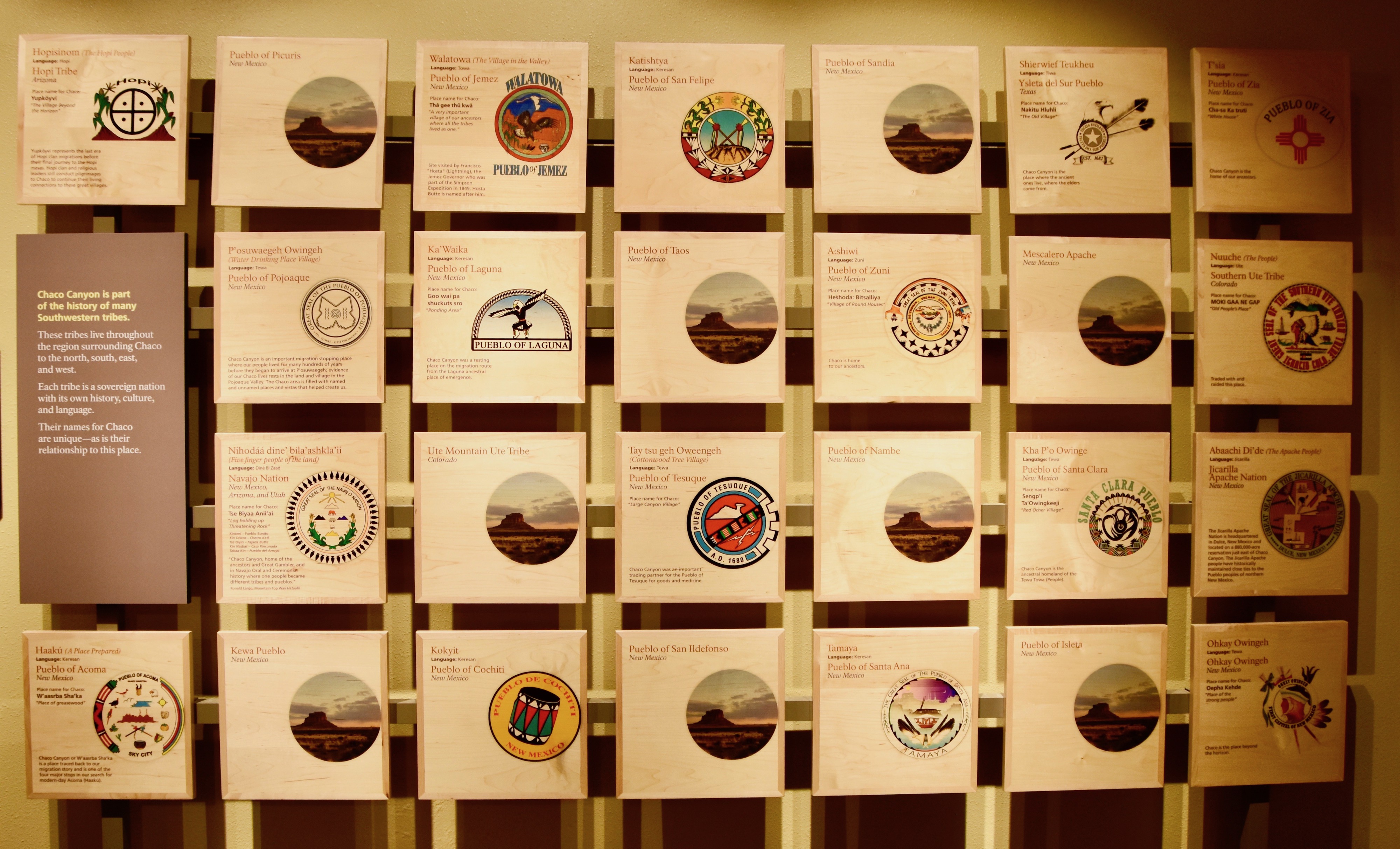
OK, it’s time to visit the pueblos. You will have noticed from the park map that there is an oblong route that takes one by motor vehicle to parking areas where it is an easy walk to visit the pueblos. The road is paved and eight miles (13 kms.) in length. Unlike Bandelier and Gila Cliff Dwellings you won’t need to climb any ladders to see the highlights. While it is difficult to get to Chaco Culture N.H.P., once you are there, visiting the important sites is quite easy.
Leaving the Visitor Center and looking east you see this butte with its very clearly delineated layers of differing sedimentary rocks capped with the classic western red sandstone. The only campground in the park is located near the foot of this butte.
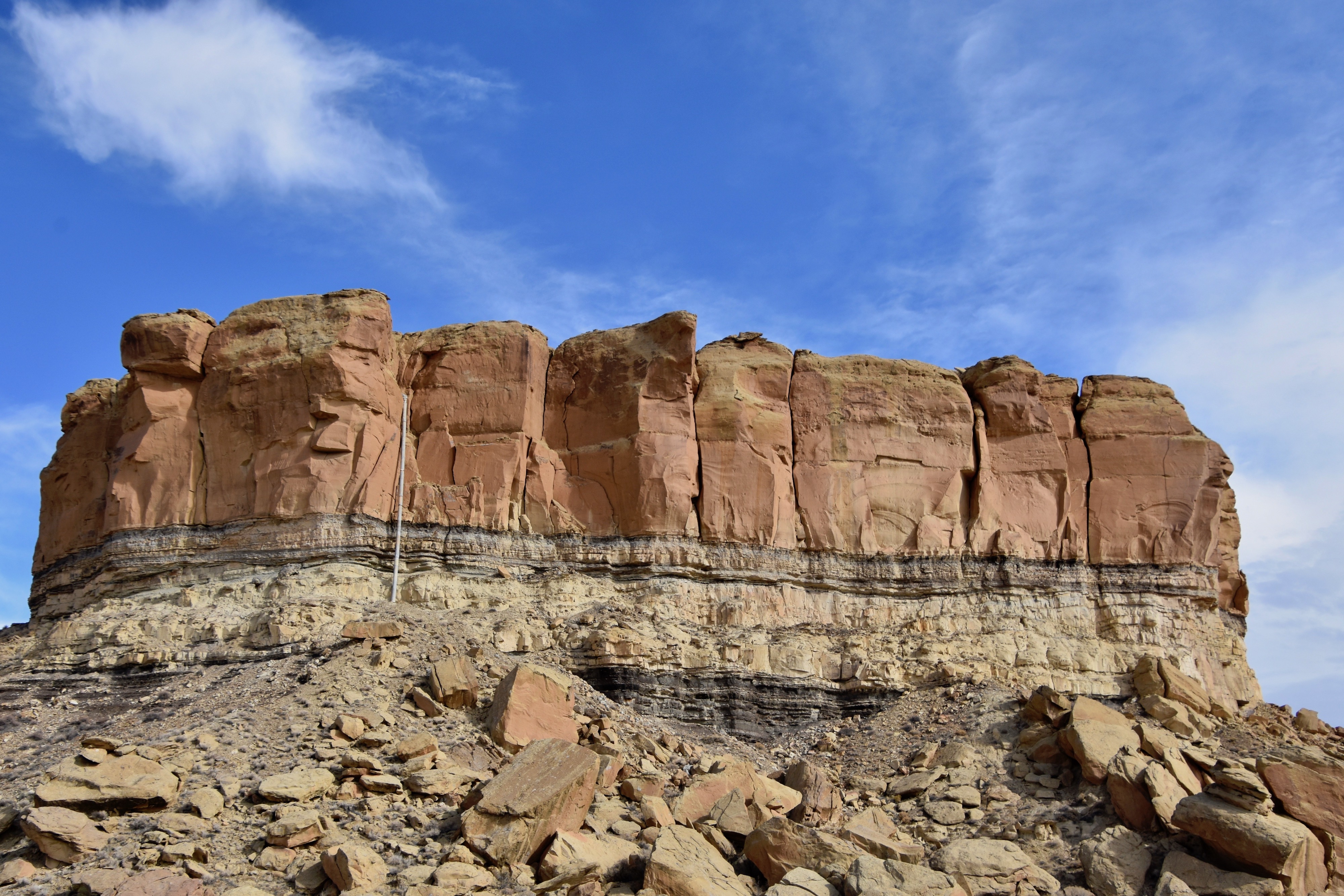
The first stop is not far from the Visitor Center and this raven seemed to be there waiting for us. For almost all the Indigenous peoples where the raven is found, and that’s most of North America, this bird is considered sacred and revered for its intelligence and cunning. I couldn’t help but think that this was a good omen for our visit.

Chetro Ketl
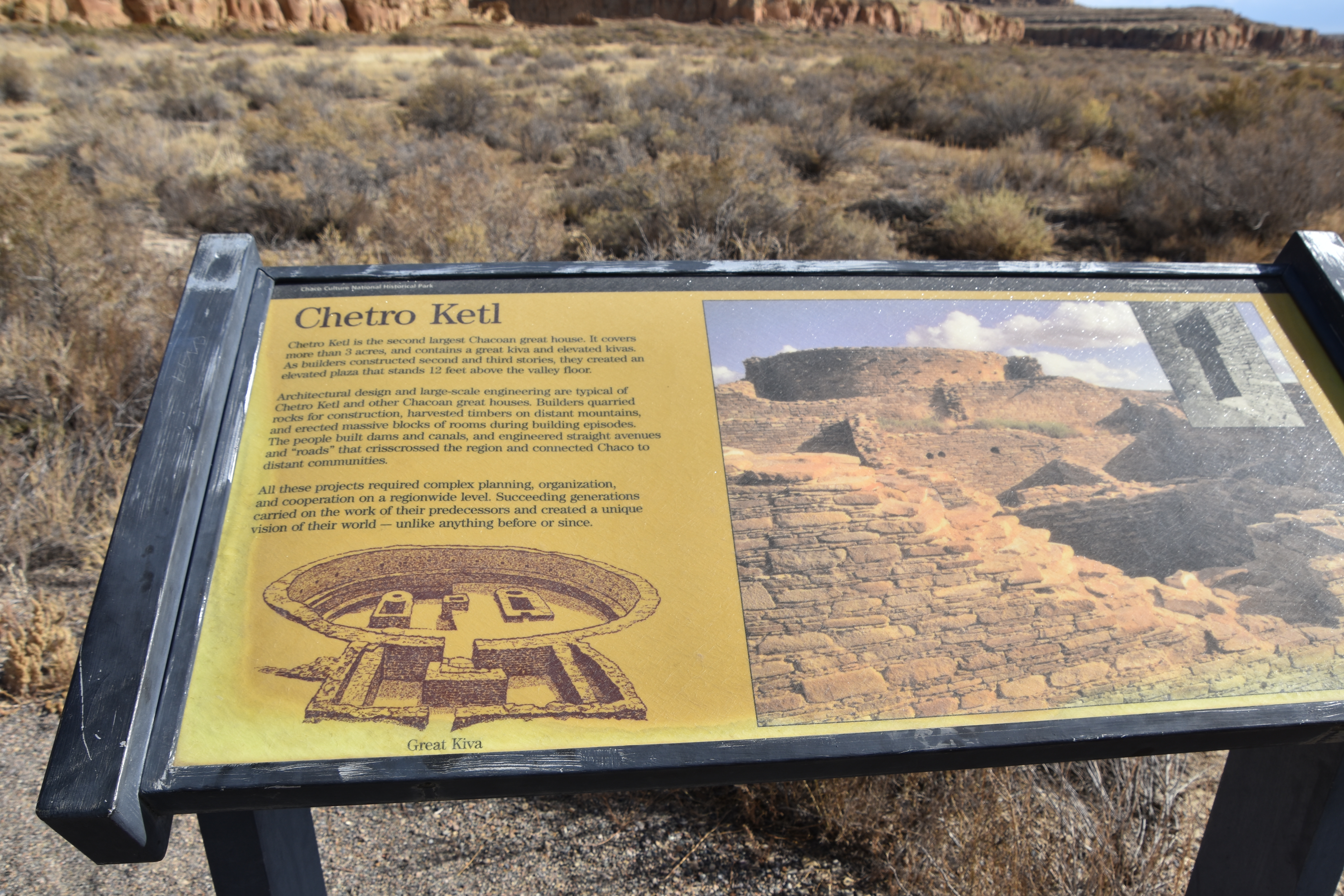
The first of the great houses on the Chaco Culture trail is Chetro Ketl which is the second largest in the park in terms of rooms, but the largest in terms of surface area, almost six acres, which does put it up there is square footage with the Colosseum. From tree ring dating archaeologists are able to identify the construction dates of these great houses with great accuracy. Chetro Ketl was constructed between 1040 and the early 12th century and then abandoned.
This is the path that leads up to Chetro Ketl from the parking lot. Visiting here in early November meant we had the site almost entirely to ourselves and weather conditions were perfect.
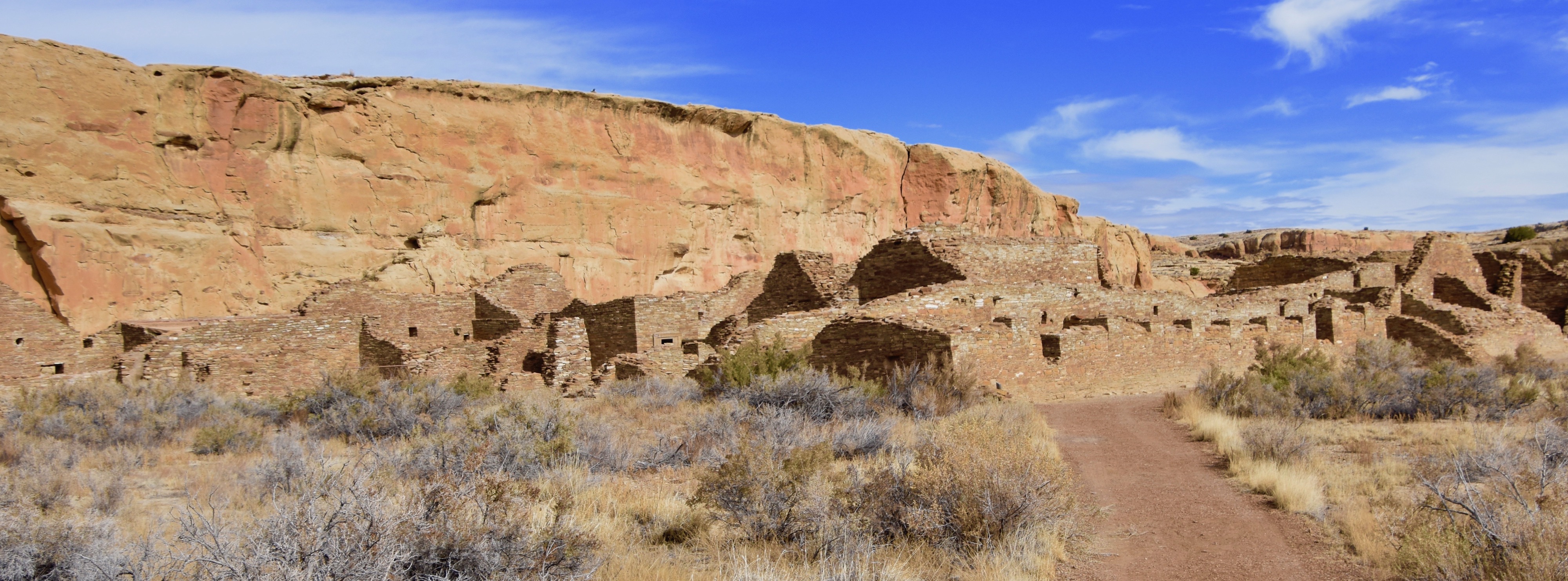
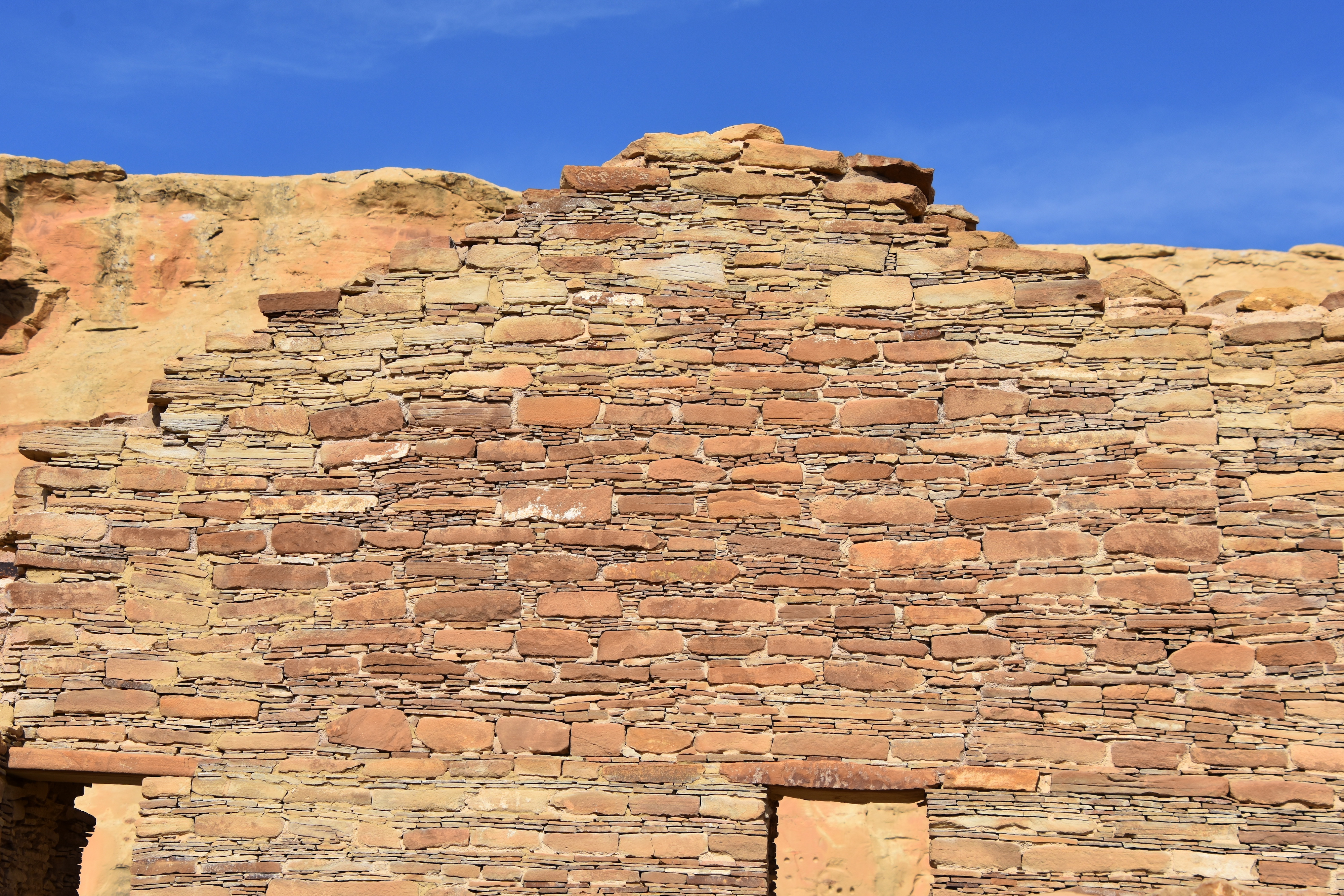
As you reach the first building you get an idea of the construction techniques used to build the great houses. Sandstone was ‘dressed’ and then mud mortar was used to put the rocks in place in a combination of large and small pieces with larger lintel stones over the doorways. Apparently there would have been a veneer covering over the bricks giving it a very different apppearance than what we see today. The interior rooms walls were covered in plaster which has long disappeared on most of the walls.
Here’s the kicker and just a big a riddle as to why these places were abandoned so precipitously in the late 1200’s. Nobody agrees on why these great houses were built or what their actual purpose was. At first glance it seems obvious that they must be housing units like the great apartment buildings of ancient Rome. These were surely condensed cities housing a great number of Anasazi. Not so fast. The archaeology carried out here simply has not found evidence of mass habitation. It is believed that at its peak there were no more than 5,000 to 6,000 Anasazi living in over 400 documented settlements in northwest New Mexico.
That then leads some to argue that these were giant royal palaces where the Ansasazi elite lived in splendor just like King Minos at Knossus on Crete. Tempting, but while some ancient sites of Mexico and Central America do fit this description, it doesn’t work for Chaco Culture, again because the limited numbers of people wouldn’t have supported such a hierarchal system.
The theory that is gaining ground today is that Chaco Canyon was the centre of huge religious gatherings where people from an area as large as the state of Georgia came together at prescribed times to perform sacred dances and ceremonies. Under this theory, the great houses would be comparable to the modern hotels in Mecca where hundreds of thousands of hajjis are put up each year during the annual pilgrimage.
Whether one theory will ultimately prevail based on greater archaeological study, who is to say? It’s just fascinating to be standing on the site knowing that these massive archaeological remains are as mysterious today as they ever were.
One of the features of Chaco Culture is the presence of so many kivas. A feature of all Puebloan Indigenous peoples and still in use today, these are subterannean structures where many of the religious ceremonies of the people were/are performed. Alison and I encountered them at Bandelier and they can be either communal or personal.
At Chaco Canyon there are the mothers of all kivas, six great kivas in all like this one at Chetro Ketl. It would have had a wooden roof and was exclusively used by men. The rounds holes are called sipapus and represent places from which the ancestors first entered the world. Kivas are also closely associated with kachinas which most people think of as the dolls often sold in Native American shops throughout the southwest. However, the real kachinas are ancestral spirits that have great significance to the Pueblo people. There are apparently over 400 of them of whom Kokopelli is the best known and has become ubiquitous in New Mexico and Arizona. In deference to the kachinas, Indigenous people for centuries have donned colourful costumes repesenting dozens of types of animals and performed the kachina dances which are both sacred and in some places, a major tourist attraction.
With a little imagination one can see the ancient Anasazi kachina dancers doing their thing in this great kiva.
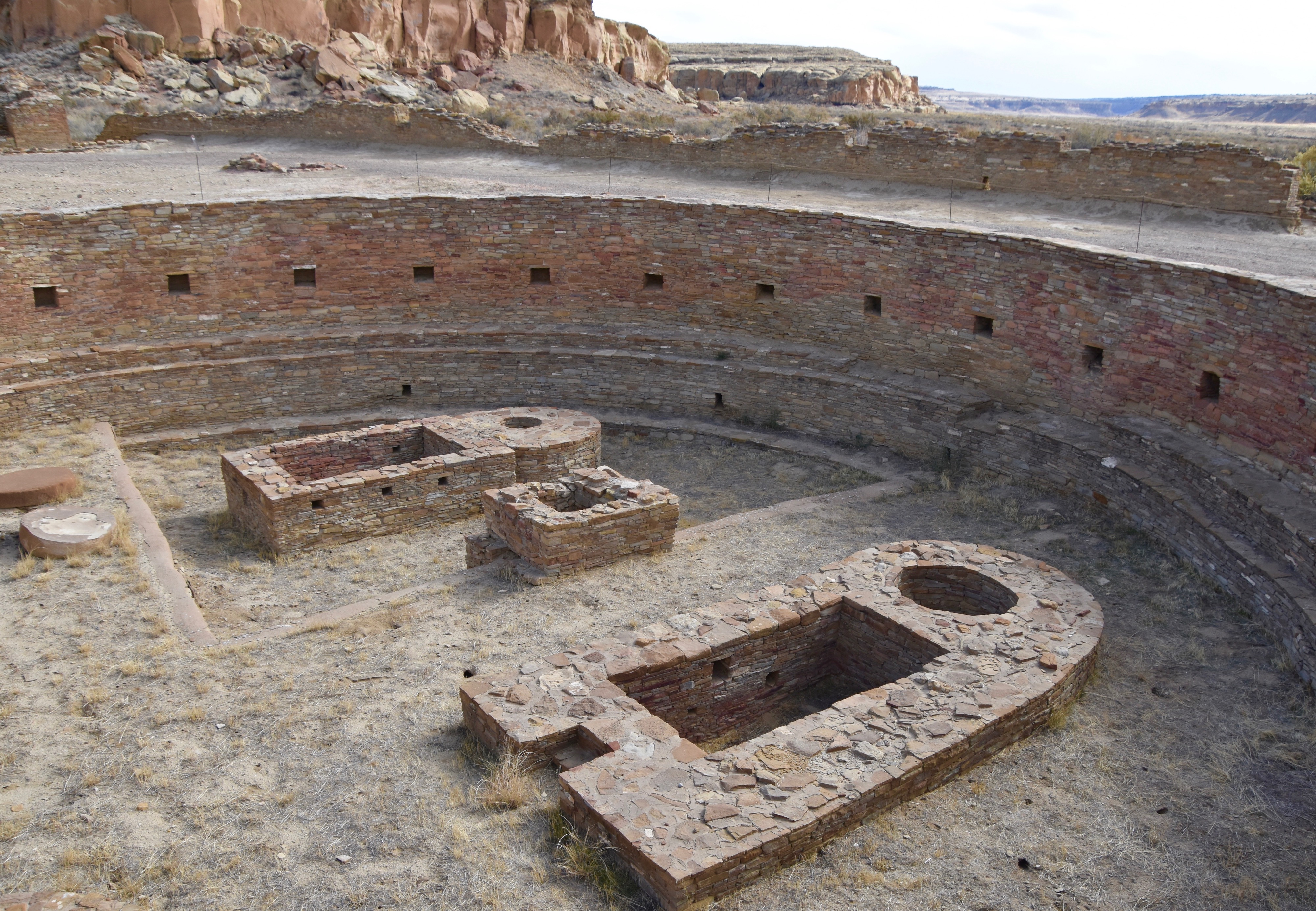
It’s in remarkably good condition and this photo of Alison on the other side shows how big it is.
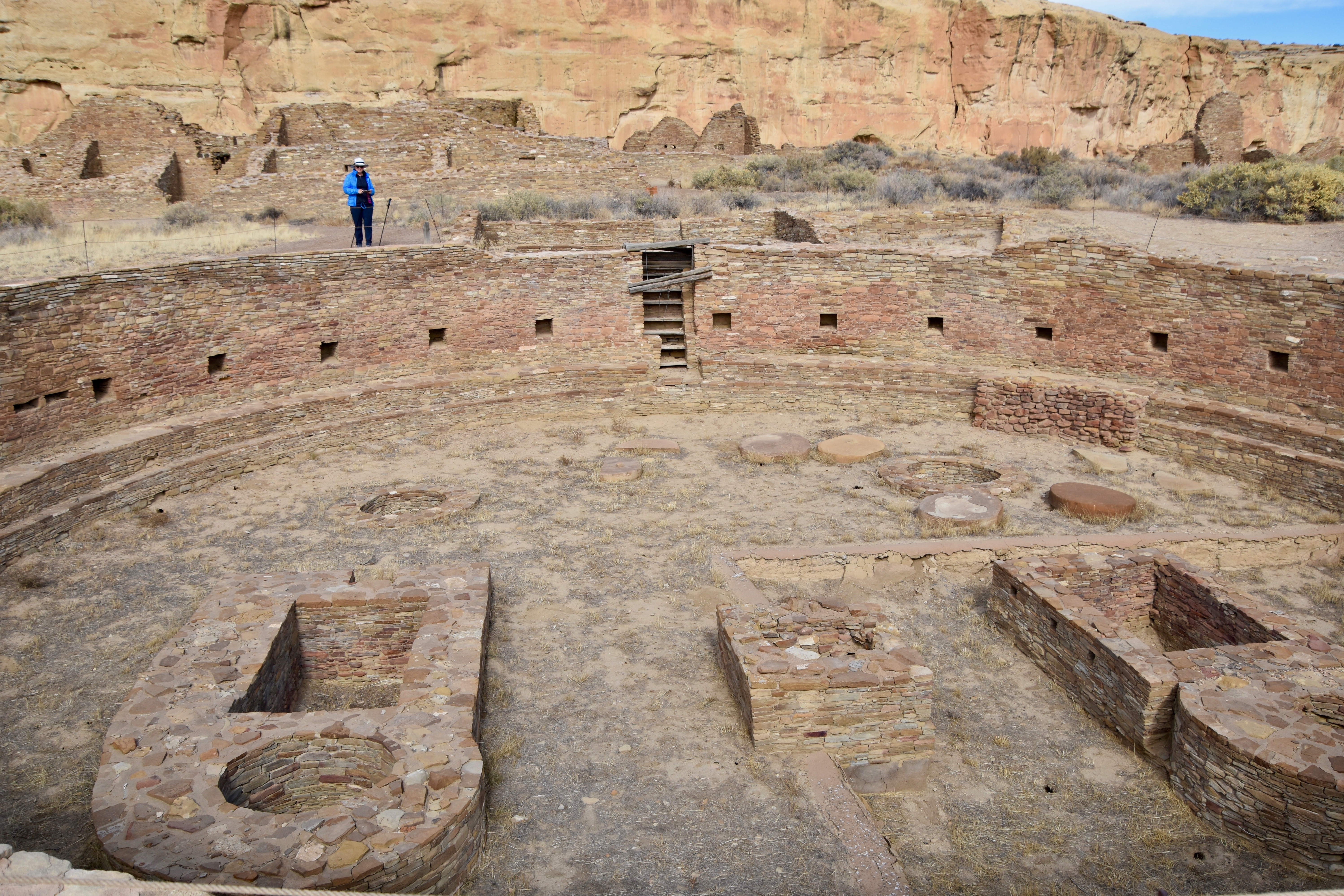
Stepping back one can get a view across the great kiva to the buildings of Chetro Ketl. We’ll visit them next.
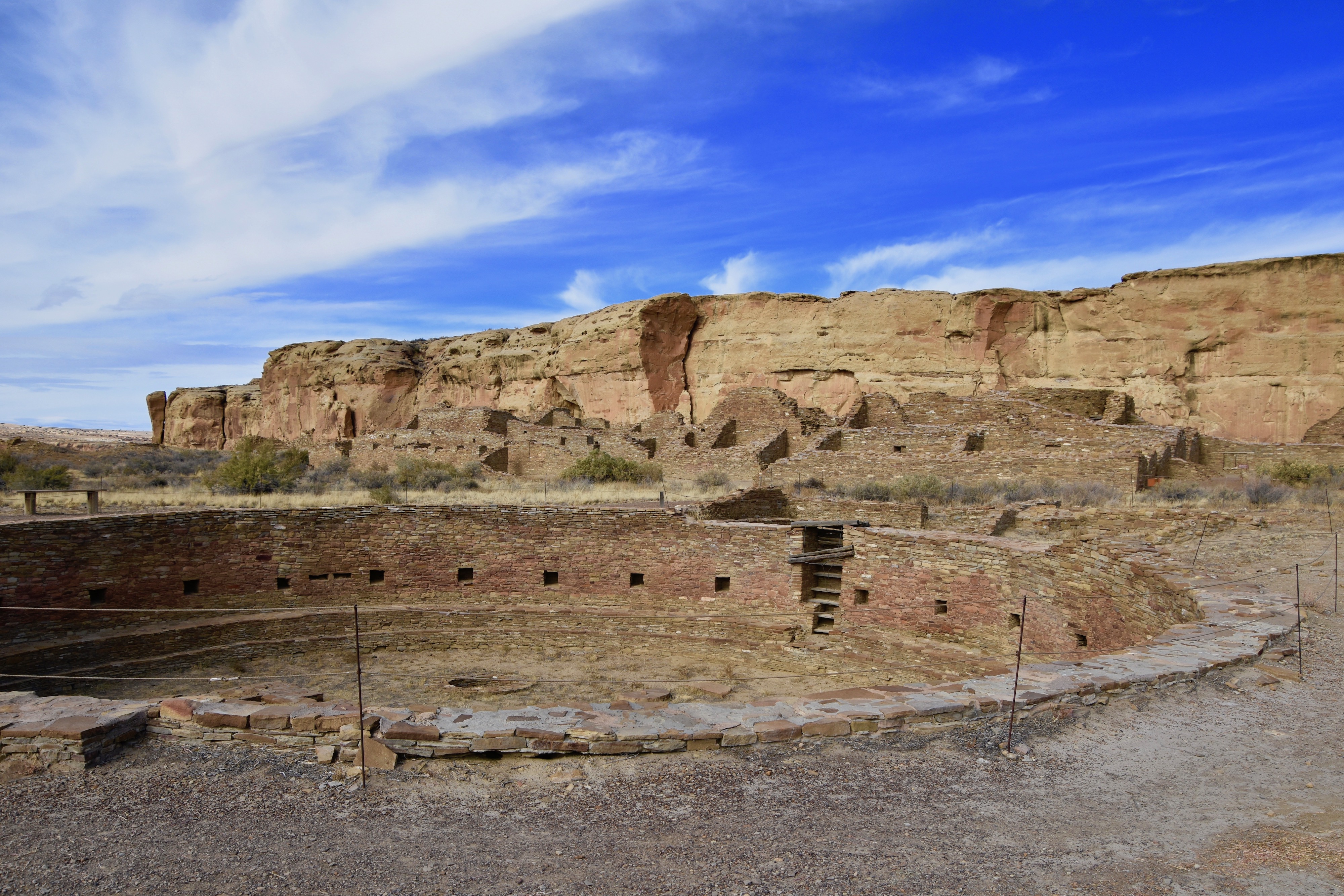
While I could bring to mind the kachina dancers at the great kiva, it is very hard to visualize that these ruins once stood four stories high and contained up to 400 separate rooms.
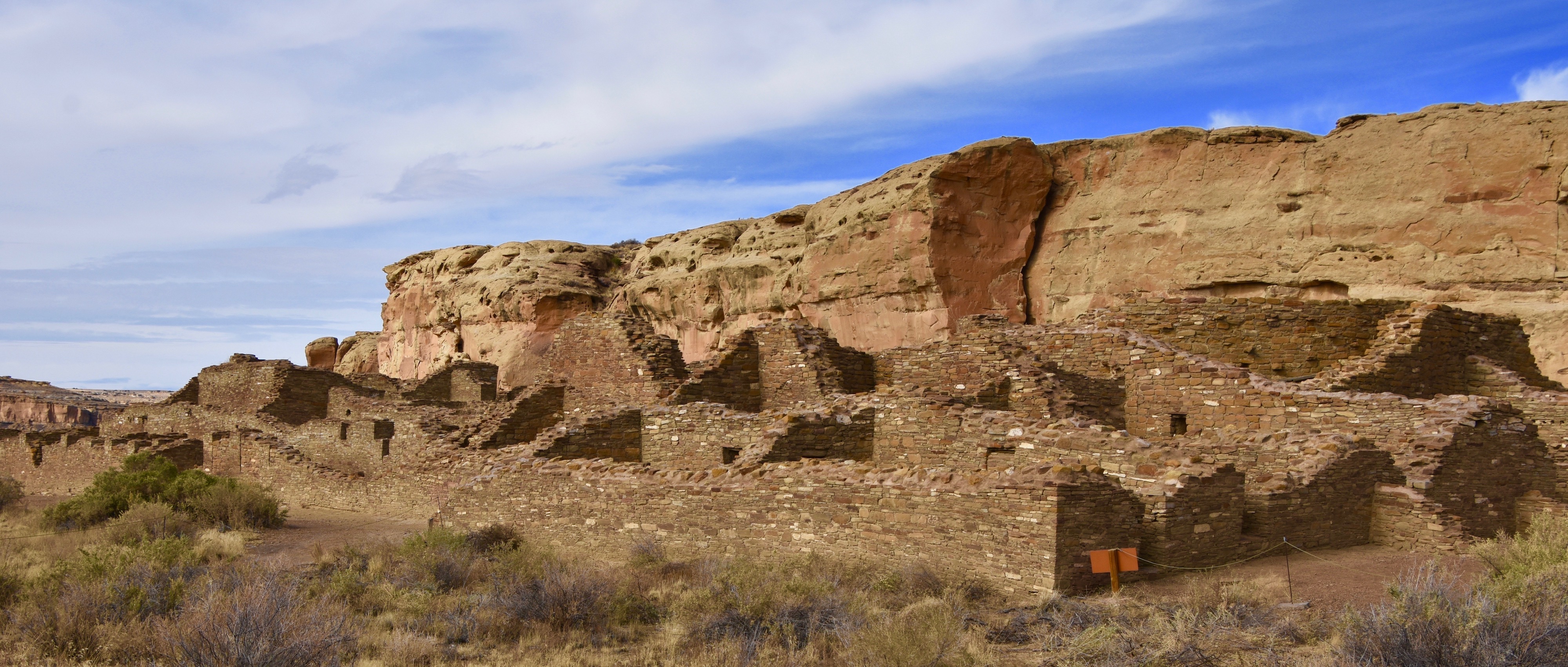
You are not allowed to enter the rooms at Chetro Ketl, but you can get a good idea of what they looked like from this vantage point. They are remarkably similar to Roman ruins which would have been constructed from brick and not stone, but in much the same fashion.
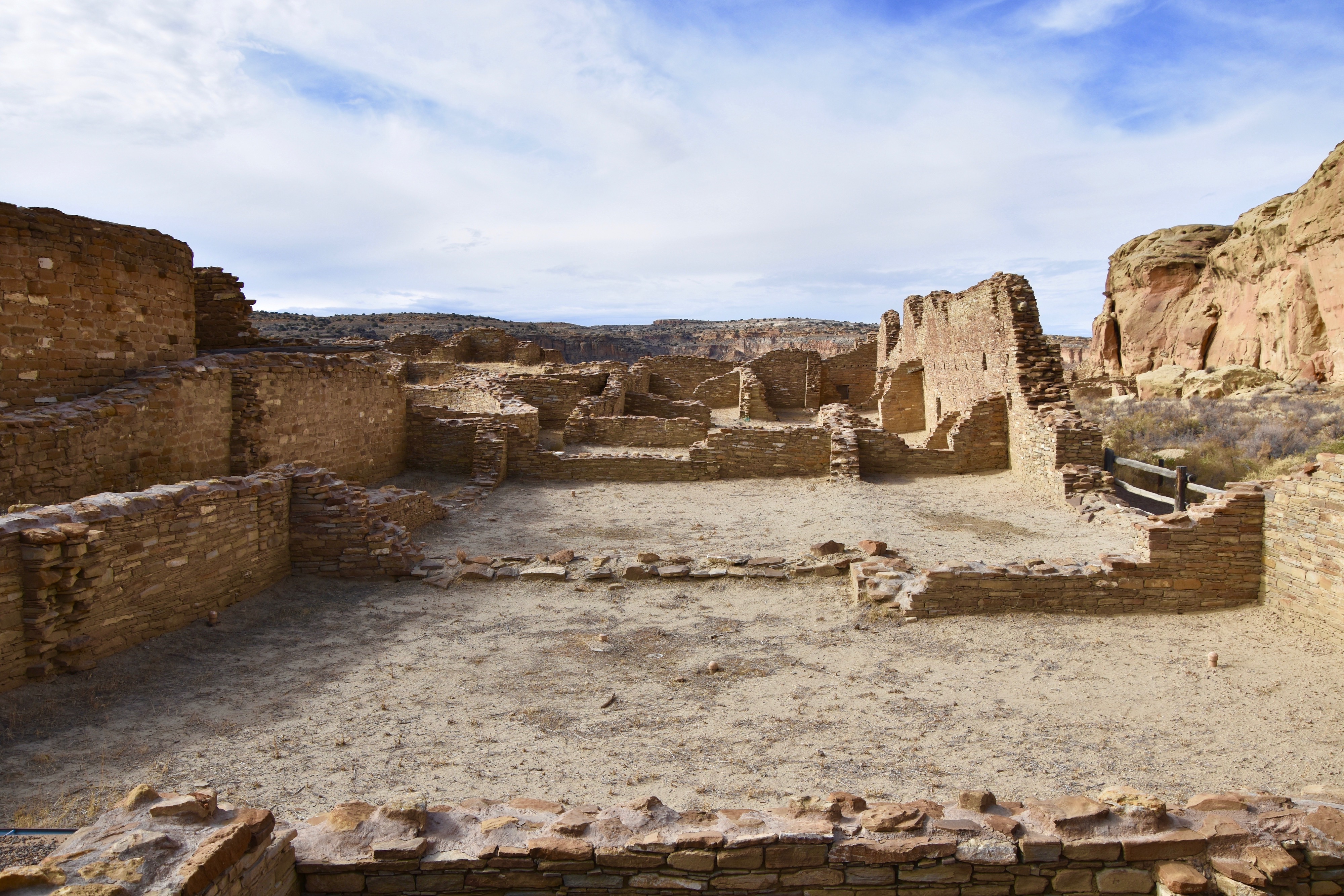
This is the back wall of Chetro Ketl that faces the canyon walls.
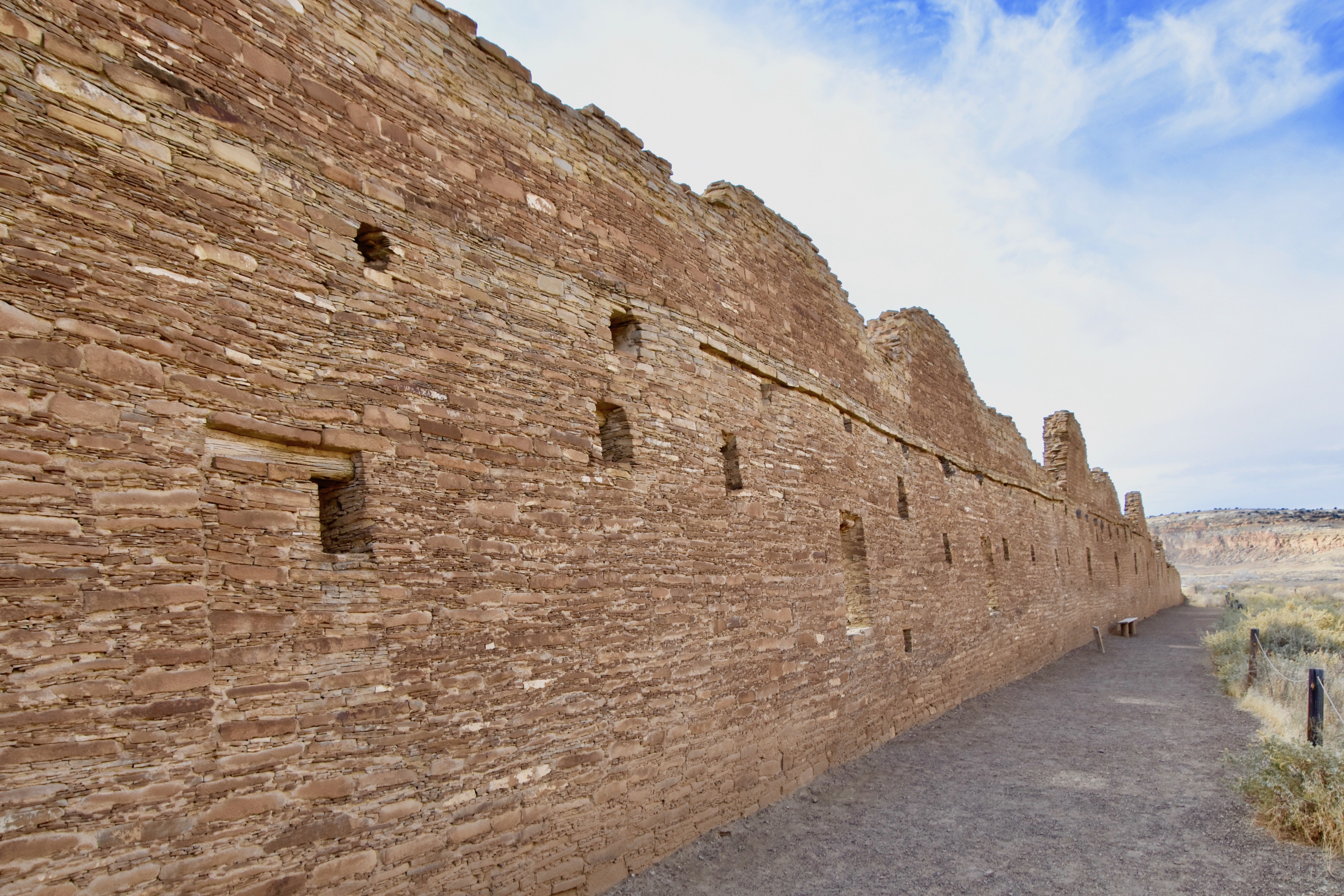
Petroglyph Trail
Between Chetro Ketl and Pueblo Bonito there is ¼ mile trail that has thirteen stops of interest and starts just past these last small foundations at the bottom of the cliff. I strongly urge forking out the $2.00 required to buy a small brochure, Petroglyph Trail Guide that will help you interpret the petroglyphs along this short trail.
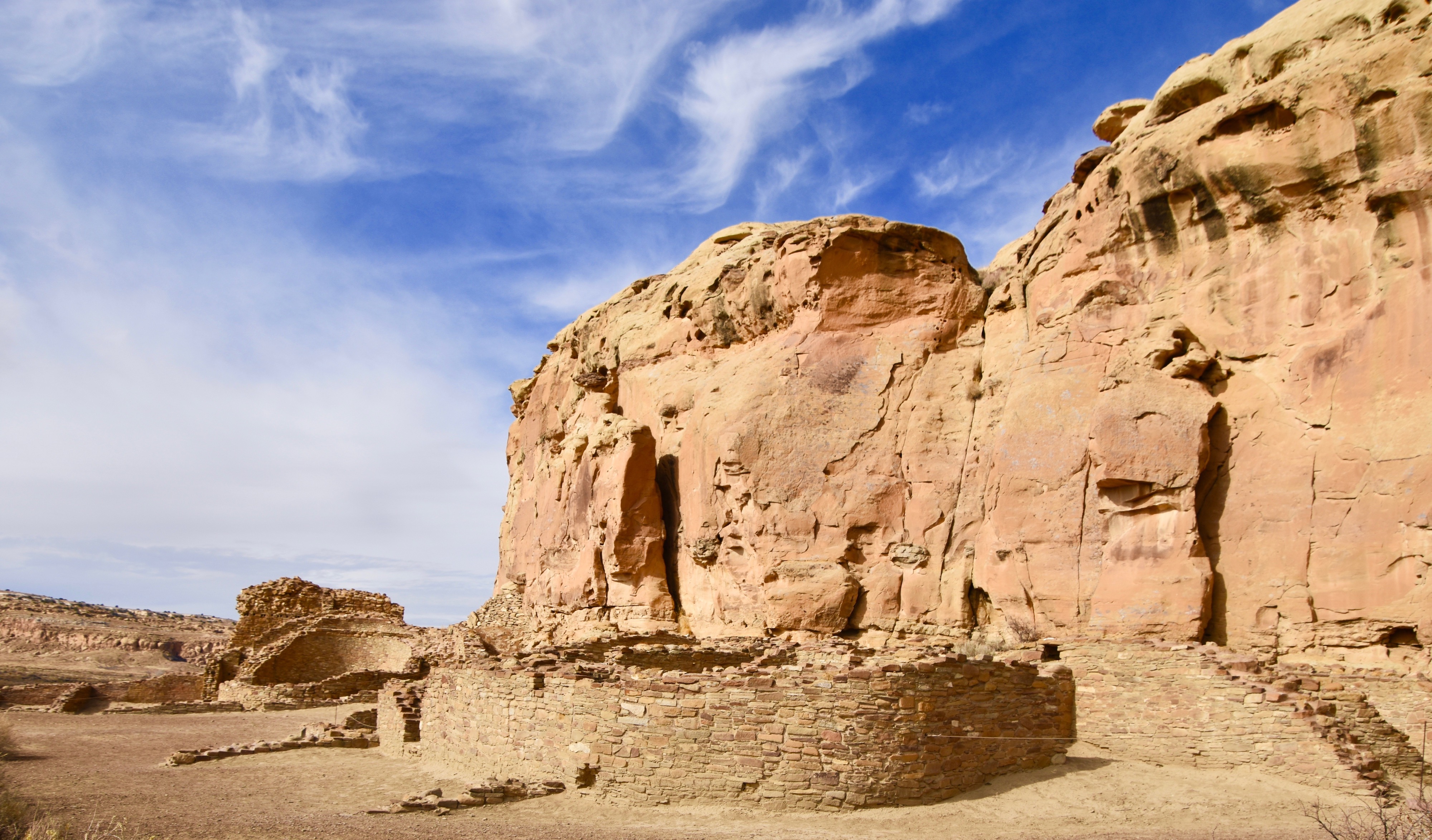
This is the first petroglyph you will see on this trail and while to me it looks like a human figure, like all things Anasazi, it’s not that simple. There is no consensus among archaeologists as to what the Anasazi petroglyphs represent or why they were carved. This could be a man, but it could also be a kachina. It could be merely a piece of art or part of a ceremonial ritual or maybe even a trail marker, like an ancient highway sign. The interesting thing is that while non-Indigenous archaeologists and tourists like me don’t know, the modern Pueblos do, or so their oral traditions lead them to believe.
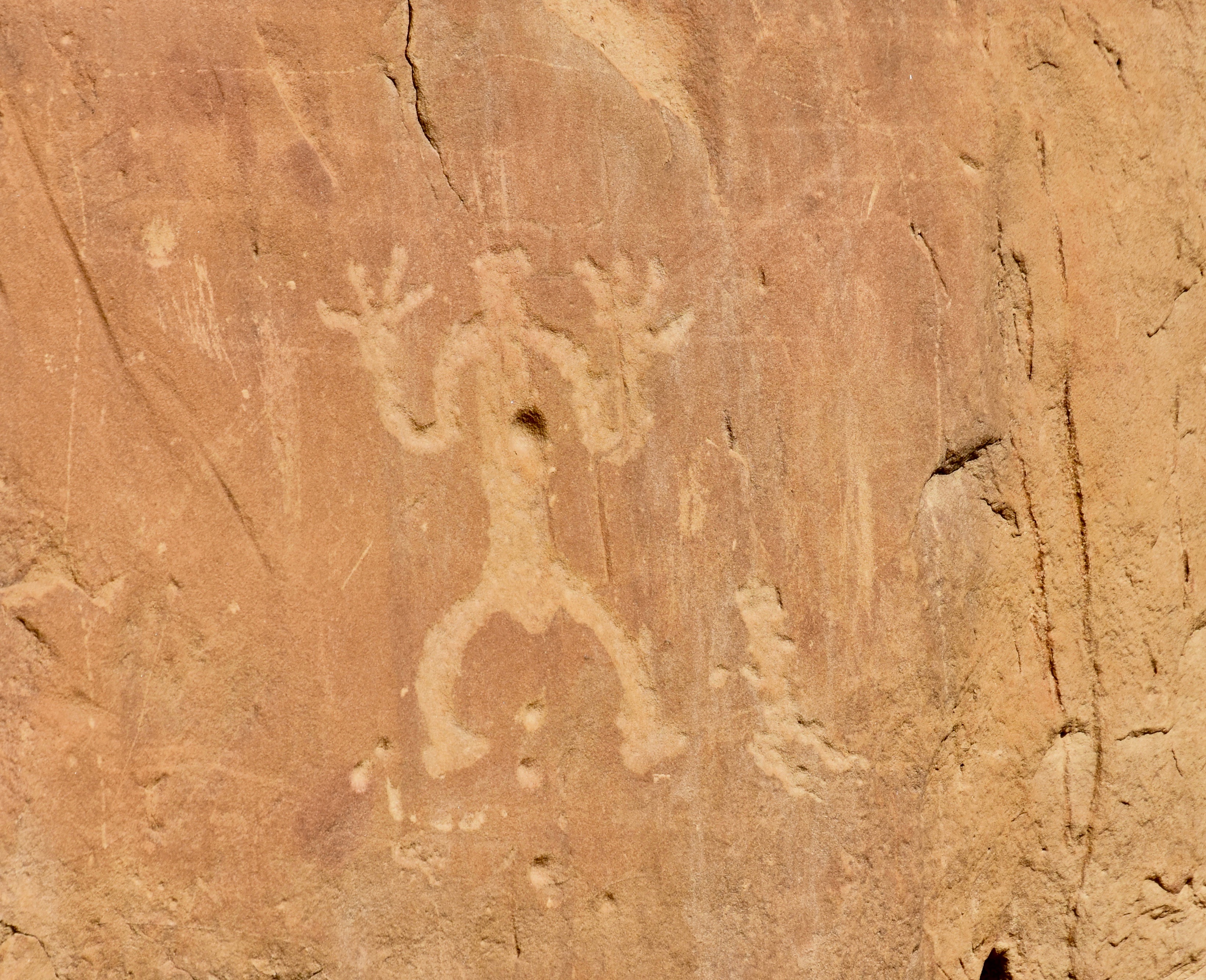
At stop 11 there are series of spirals which the brochure claims are only every found near dwelling sites in Chaco Canyon and are believed to date from the same period as the great houses were being constructed.
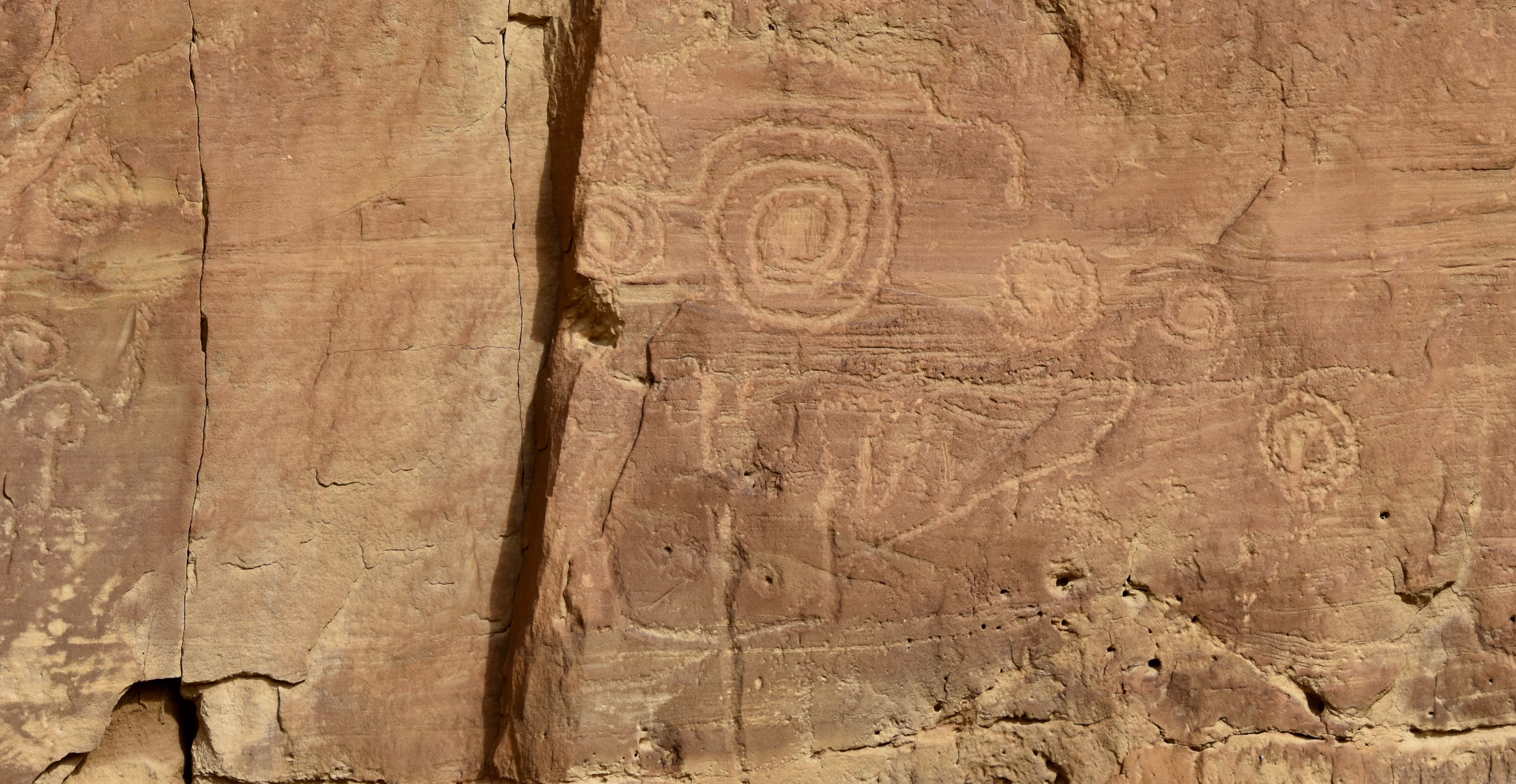
Petroglyphs are not the only thing you will se on the Petroglyph Trail. These are cliff swallow nests, currently not in use, but likely to raise new families come next spring.
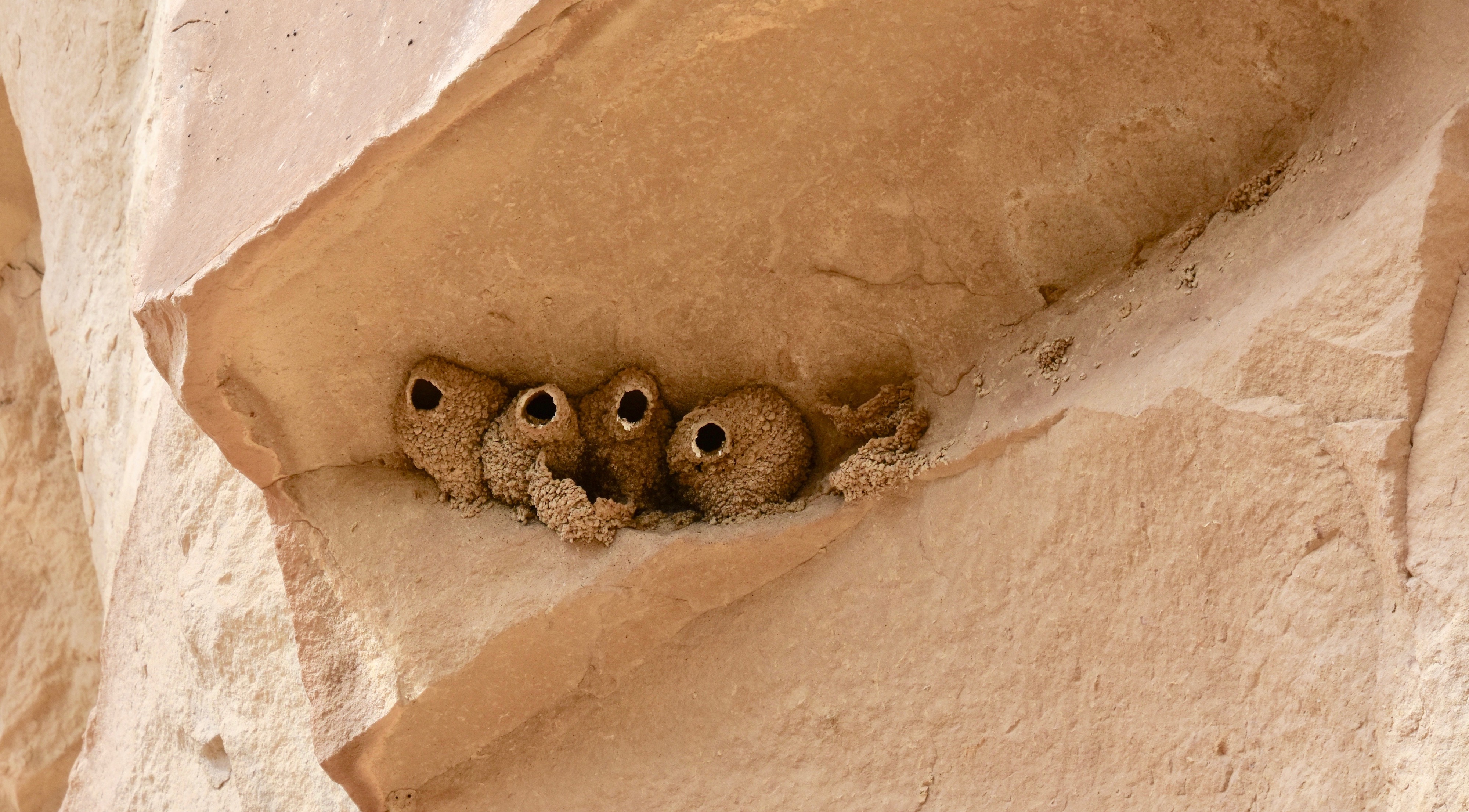
The more you looked at this set of petroglyphs the more you see – centipedes, snakes and maybe even a female figure.
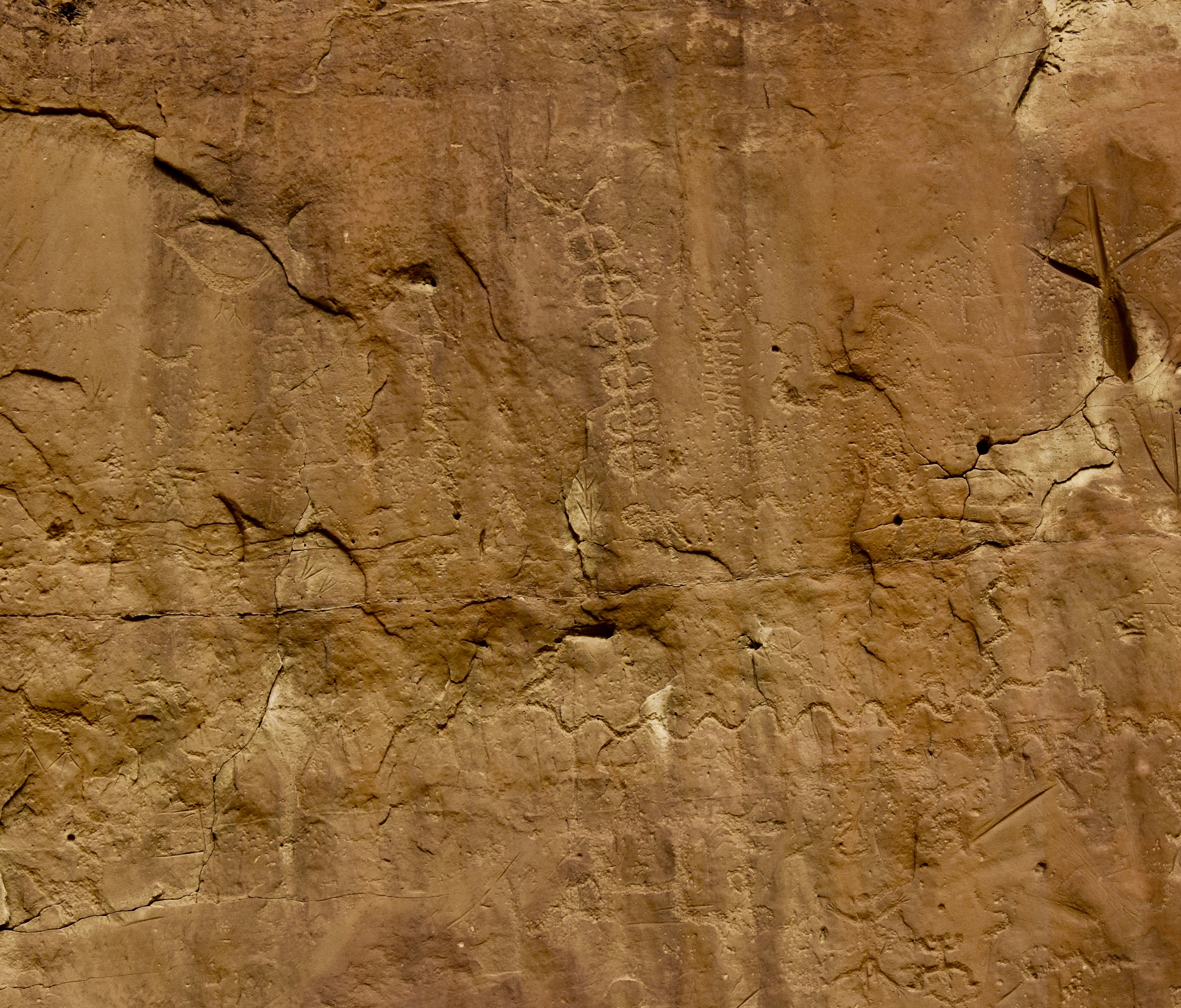
Pueblo Bonito
This is where Pueblo Bonito comes into clear view and like Chetro Ketl it’s hard to imagine just how big it once was. Once again I urge purchasing the small booklet on Pueblo Bonito that has 19 distinct stops.
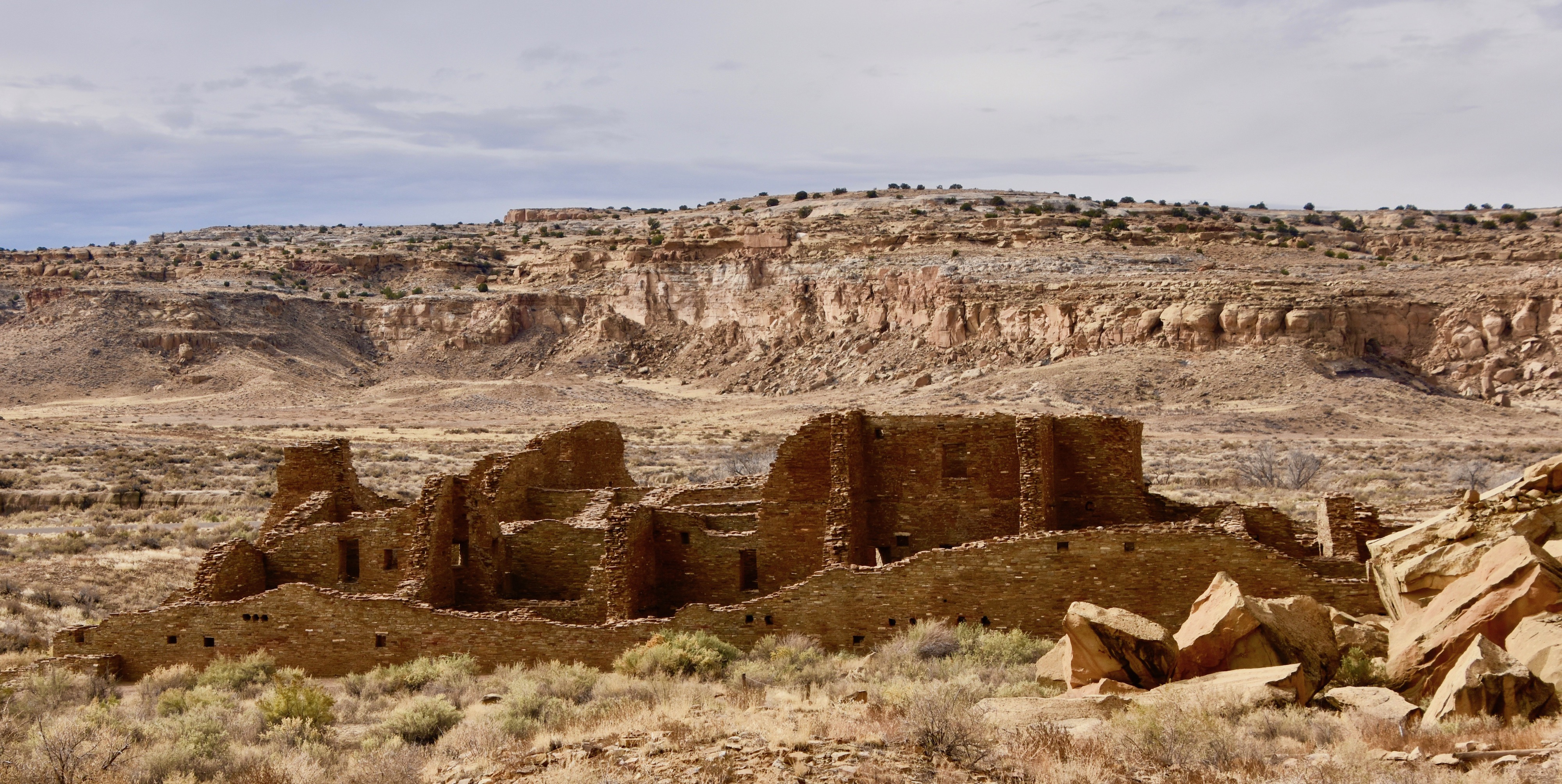
Pueblo Bonito or ‘beautiful town’ was built between 850 and 1150 and is thus is quite a bit older than Chetro Ketl. It is considered to be the best example Chacoan architecture in existence and had an incedible 350 rooms on the ground level alone, along with three of the six great kivas in Chaco Canyon.
The best way to appreciate its true size is from the air. Note the large mass of fallen rock in the upper right hand corner.
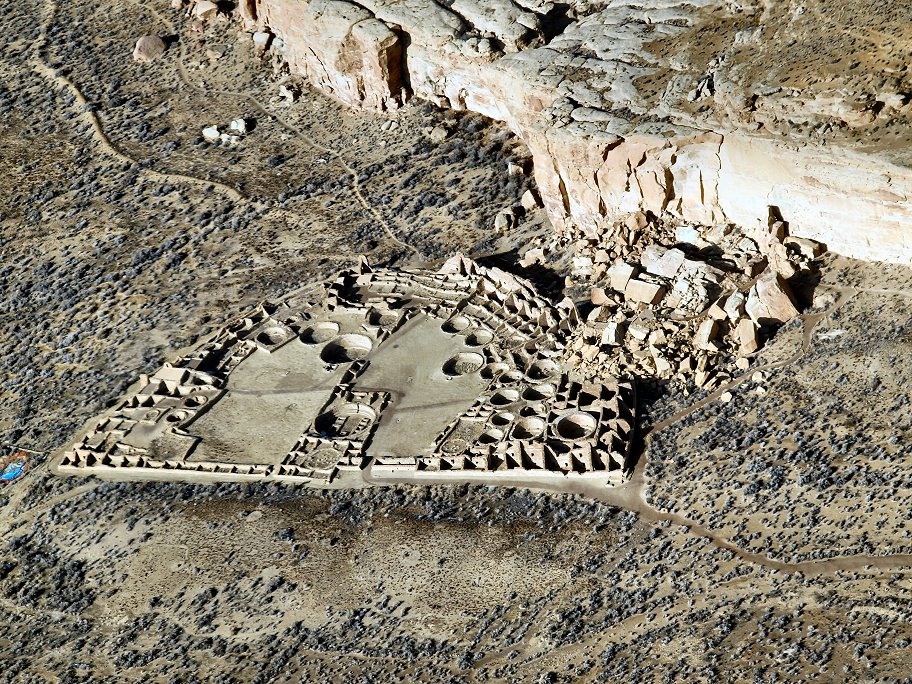
As you approach from the Petroglyph Trail you will enter the site just where this huge rock fall occurred in 1941 and destroyed over 35 rooms in Pueblo Bonito. The story of Threatening Rock as the formation was called before its collapse dates, according to this article written before the collapse, all the way to 1050. Archaeologists working on the site in the 1930’s discovered evidence that the Chacoans had been making efforts to prevent its fall by using logs that were dated to that time. Almost 900 years later, plans were actively underway to prevent its fall, but it was too little too late and you can see the devastation it wrought as you enter the site.
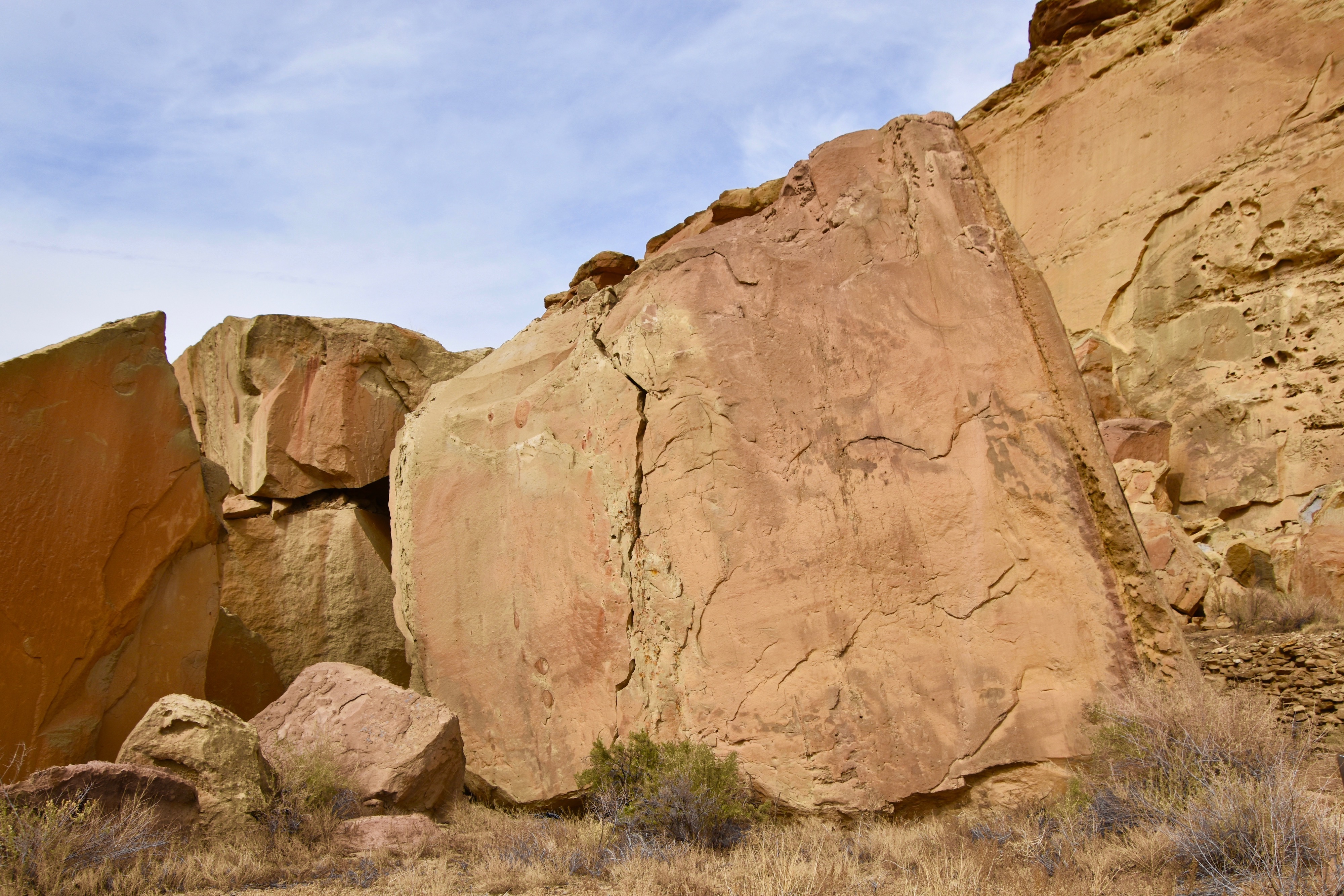
Stop 4 on the Pueblo Bonito trail leads to this point amid the rubble where you can get a better view of the entire site.
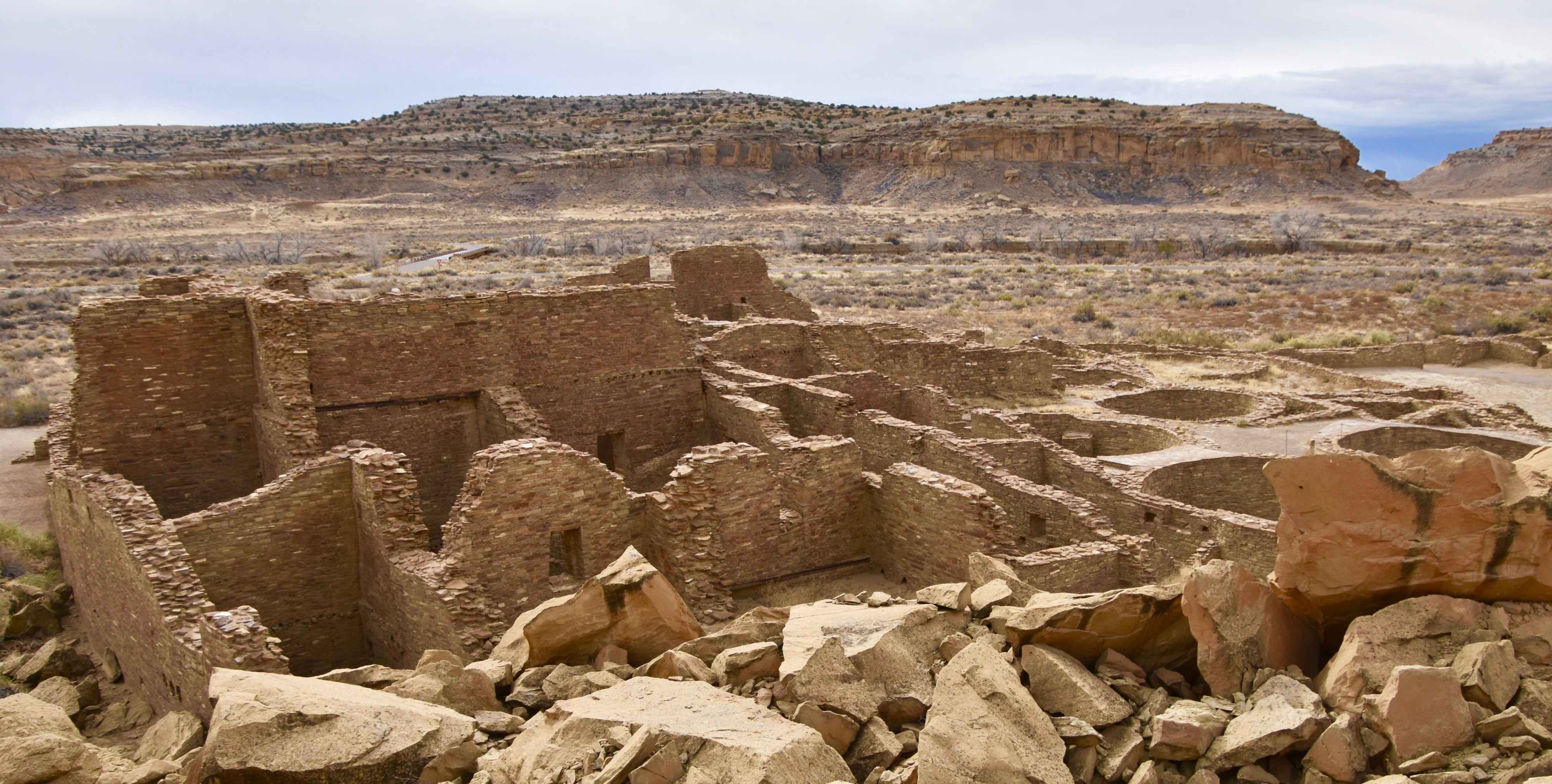
This is where I shot this short video that gives a much better idea of the grandeur of Pueblo Bonito.
This is looking down at the two main plazas and a few of the 32 smaller kivas found here. Looking across to the mesas on the far side you can see why you don’t get the feeling that you are in a canyon.
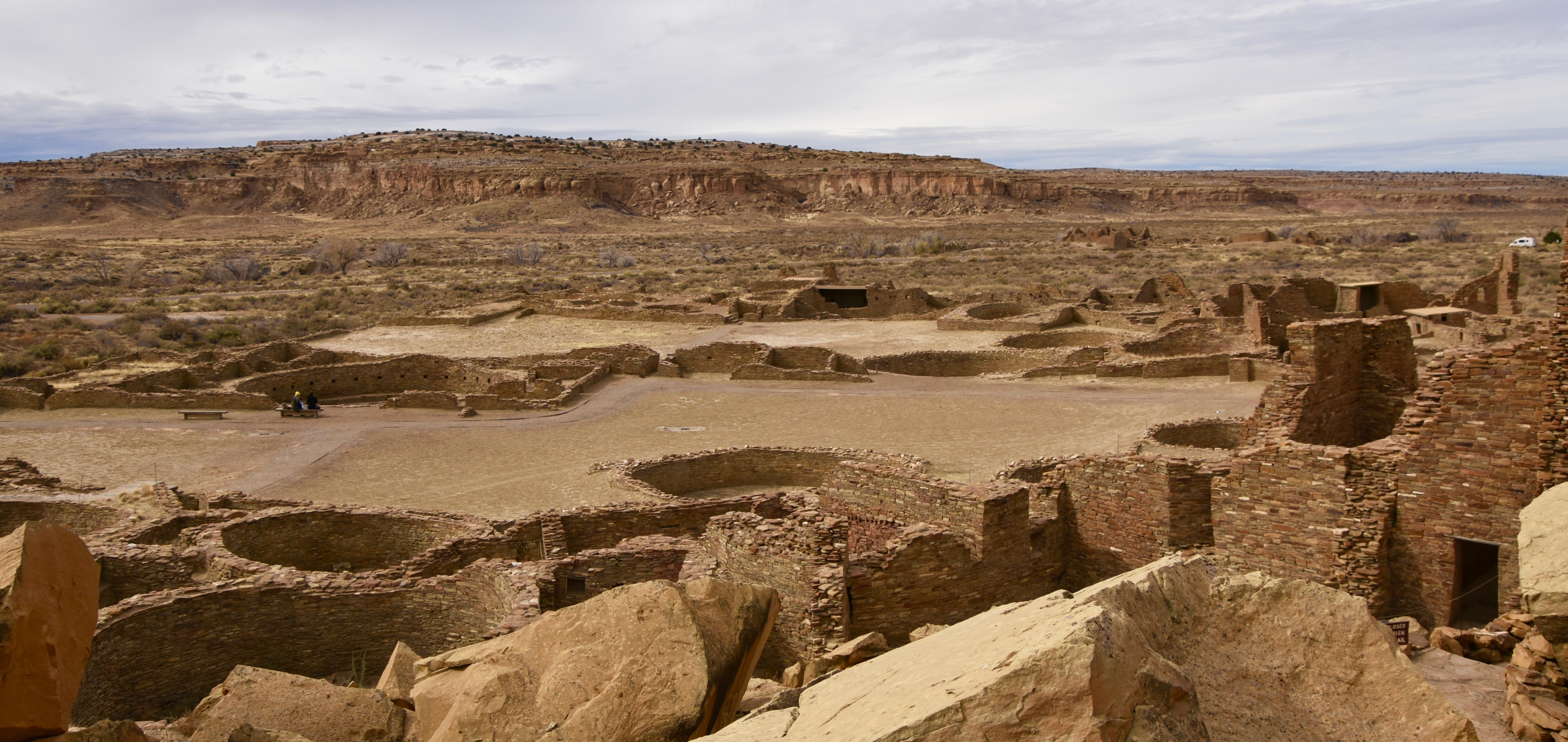
At Stop 5 on the trail you can get a better idea of just how thick the walls were and how they tapered as they increased in height. This meant that from day one the builders were planning multistory buildings and this was not a case of later stories being added as needed.
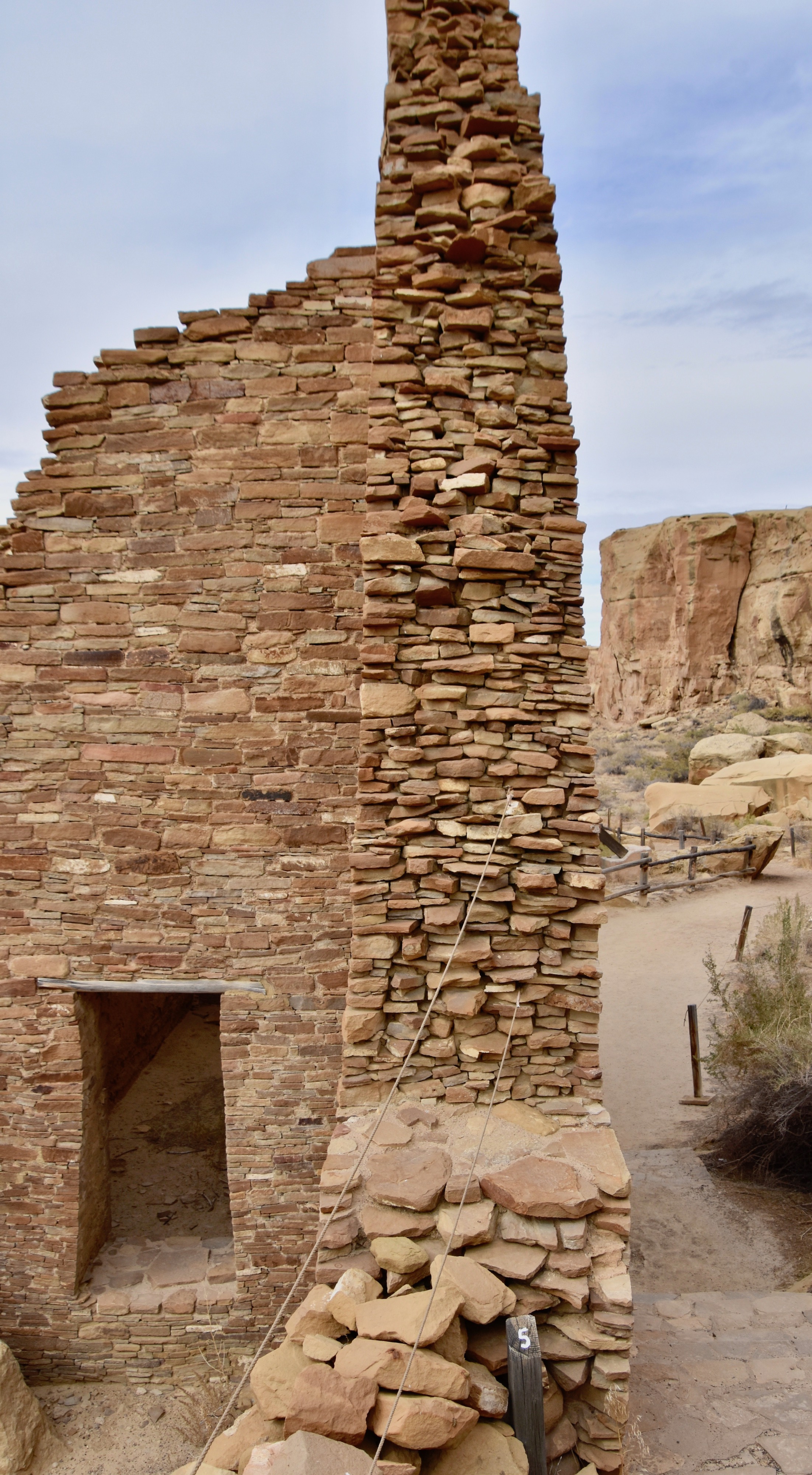
Here, unlike Chetro Ketl, you can walk through the interior of Pueblo Bonito and get a sense of its vastness.
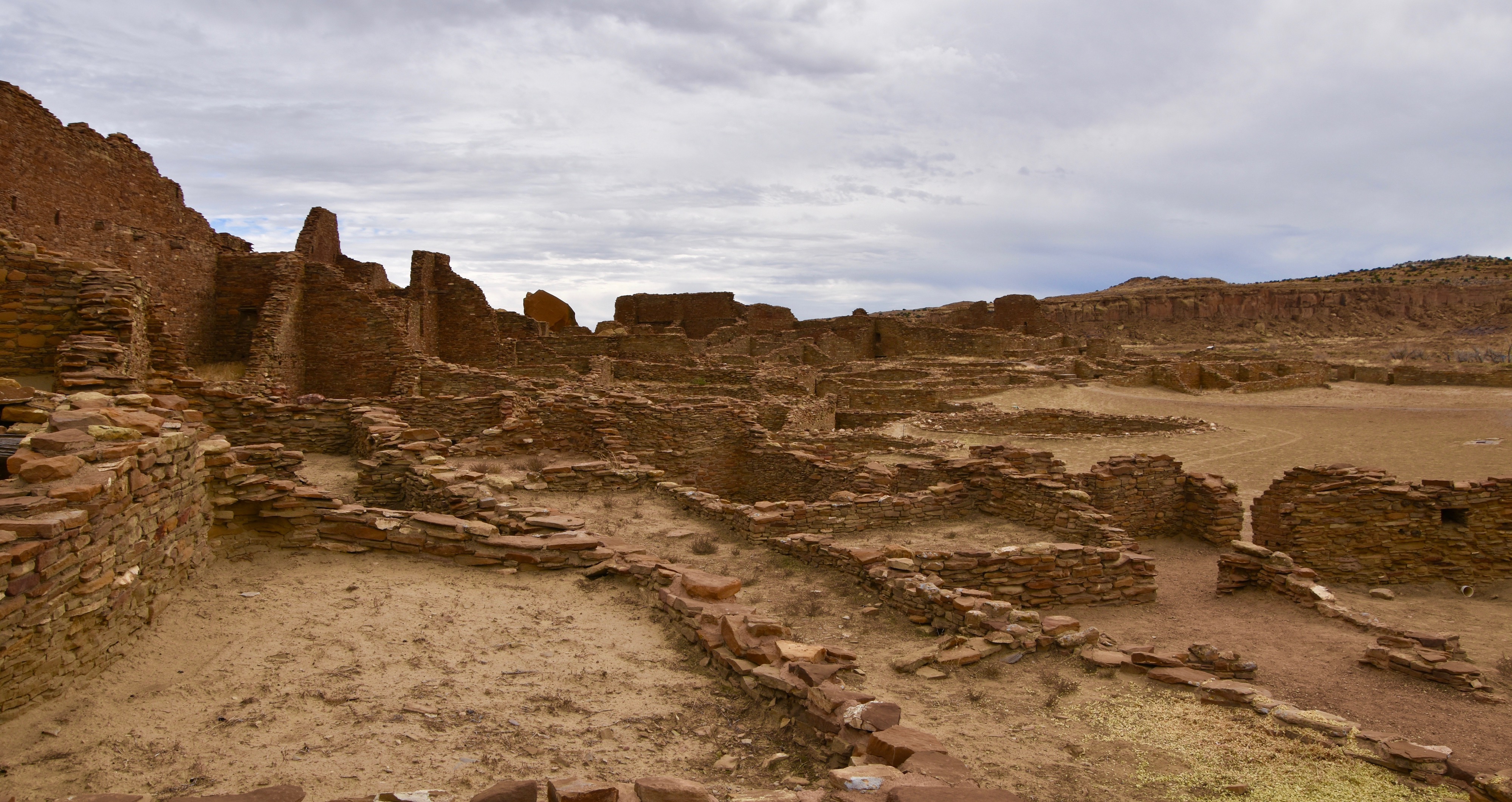
Here at Stop 8 on the self-guided tour of Pueblo Bonito you see the oldest part of the complex on the left which much less sophisticated masonry assemblage than that on the right which was made much later.
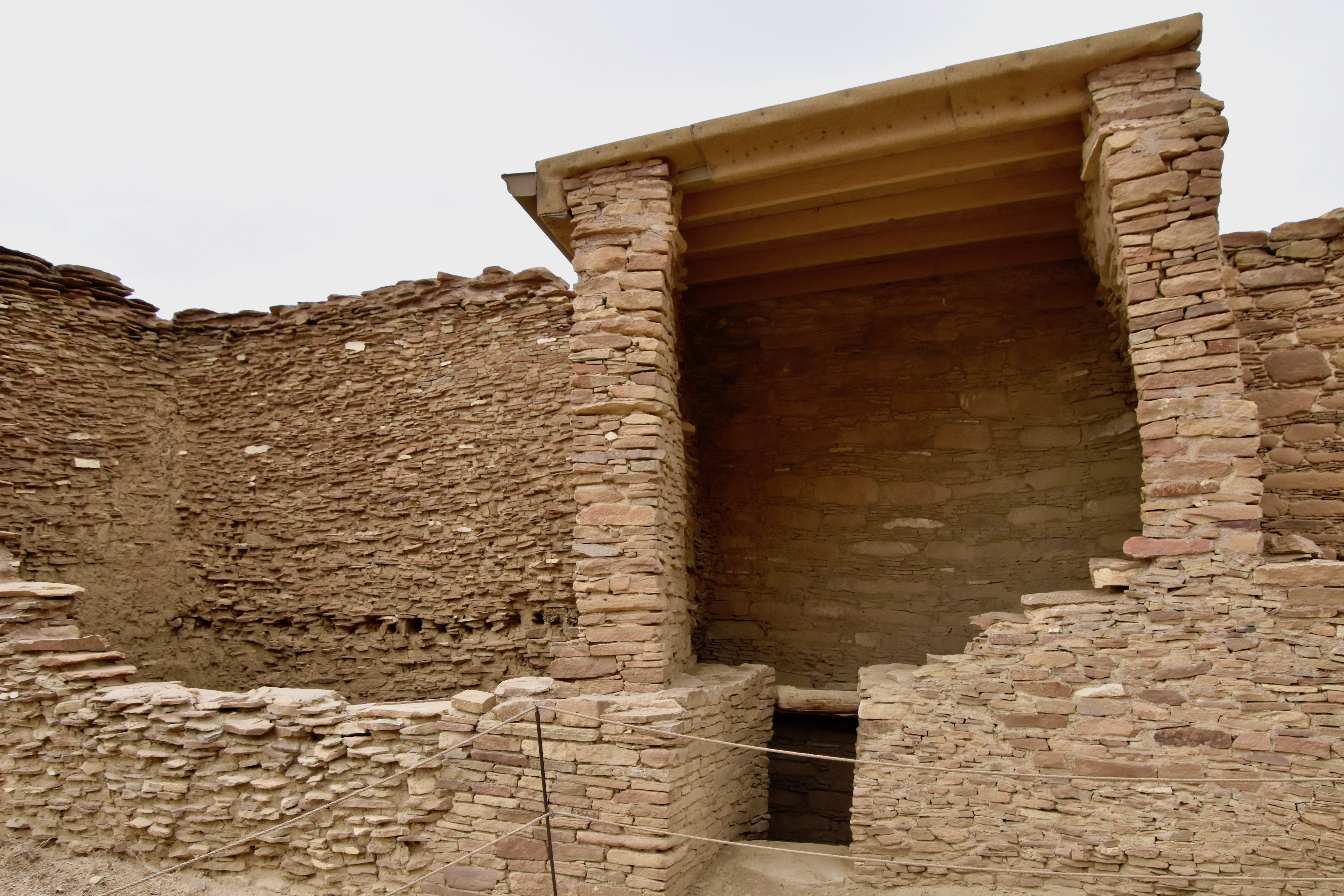
Looking toward the canyon from the interior of Pueblo Bonito you can see how well it blends in with the surroundings which only makes sense because the buildings were made of the material as the cliffs. You can also see remnants of the old logs near the top that made up the floors and ceilings of the rooms above the ground level. It is these dried logs that allow archaeologists to so accurately date these constructions.
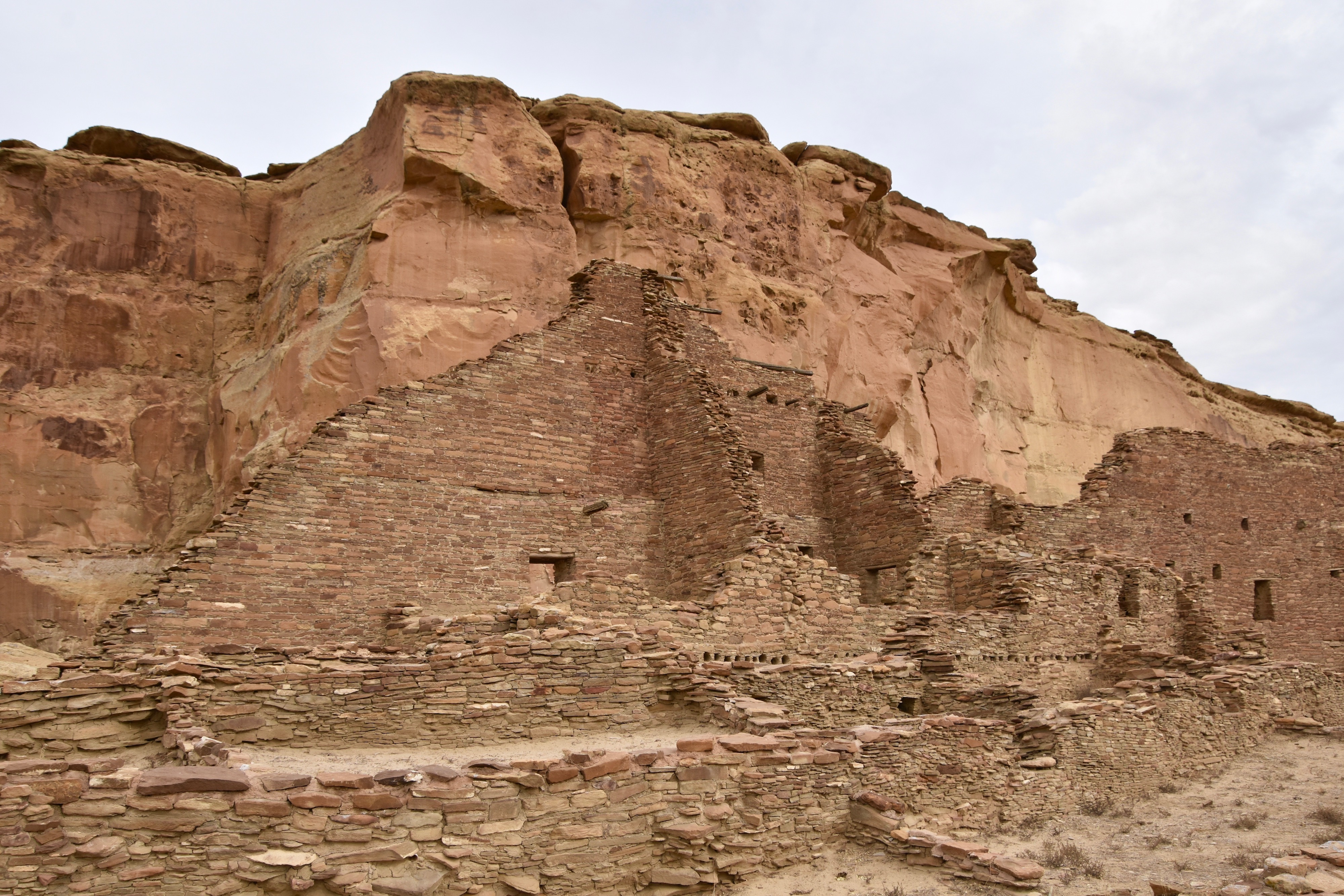
There are many lesser ruins in Chaco Canyon that can only be reached on foot. There are four hiking trails in Chaco Culture N.H.P, the shortest a three-mile (5 km.) loop and the longest 8 miles (13 km.), so nothing too strenuous. If we had had the time I would loved to have joined this solo hiker for a view of Pueblo Bonito from above.
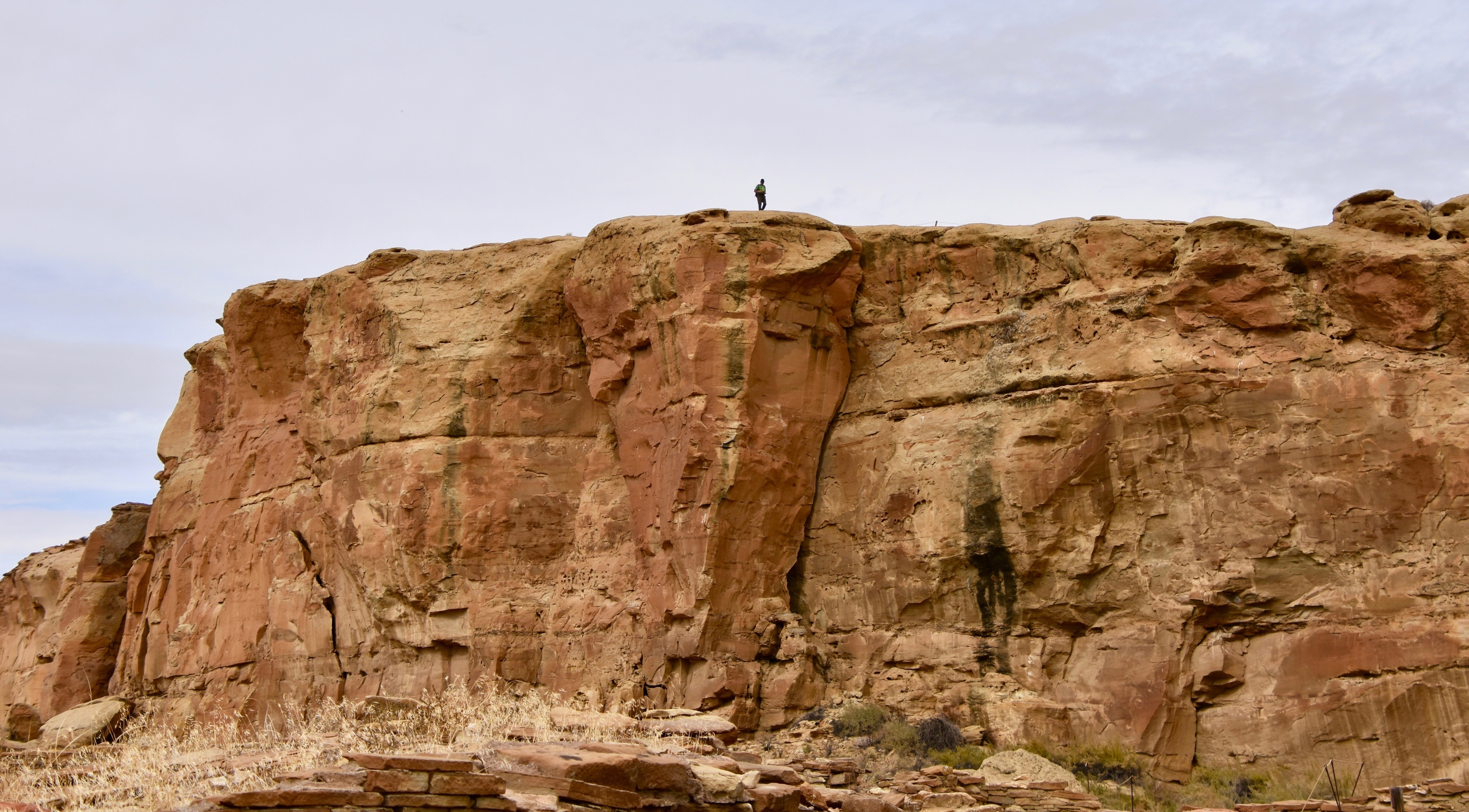
The last stop on the Pueblo Bonito tour was at one of the three great kivas at this site. Once again I imagined the kachina dancers chanting and singing here a thousand years ago, no doubt thinking that their world as they knew it would never end. As I write this we are faced with the Covid-19 pandemic and I am left to wonder if me might be at the same juncture today.
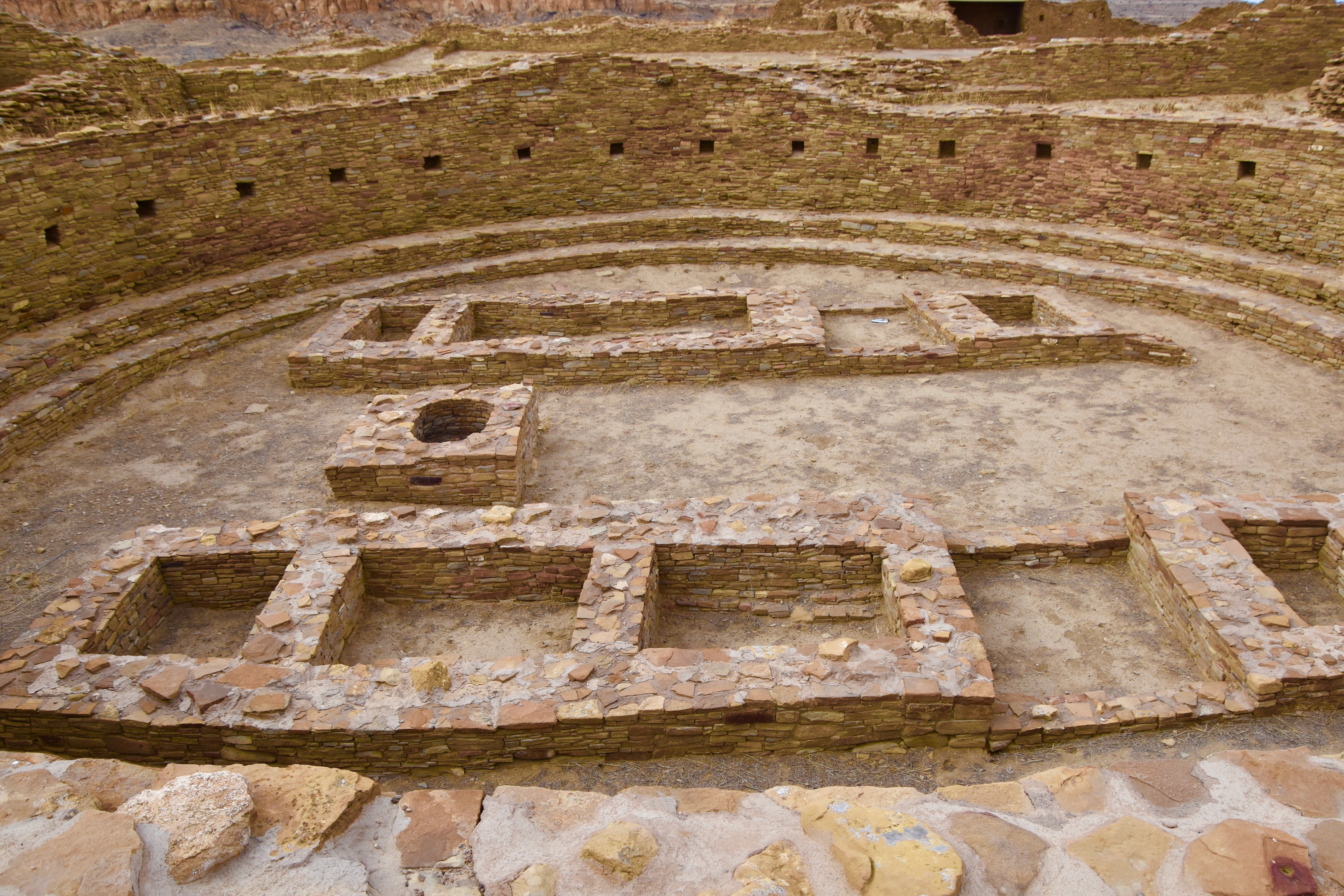
Because it takes so long to get to and from Chaco Culture N.H.P. you probably won’t spend more than a few hours actually on site. Also frankly, once you’ve visited Chetro Ketl, the petroglyphs and especially Pueblo Bonito, anything else is almost bound to be anticlimactic.
I did make a brief stop at Pueblo del Arroyo the third largest site at Chaco Culture N.H.P., but only for this photo.
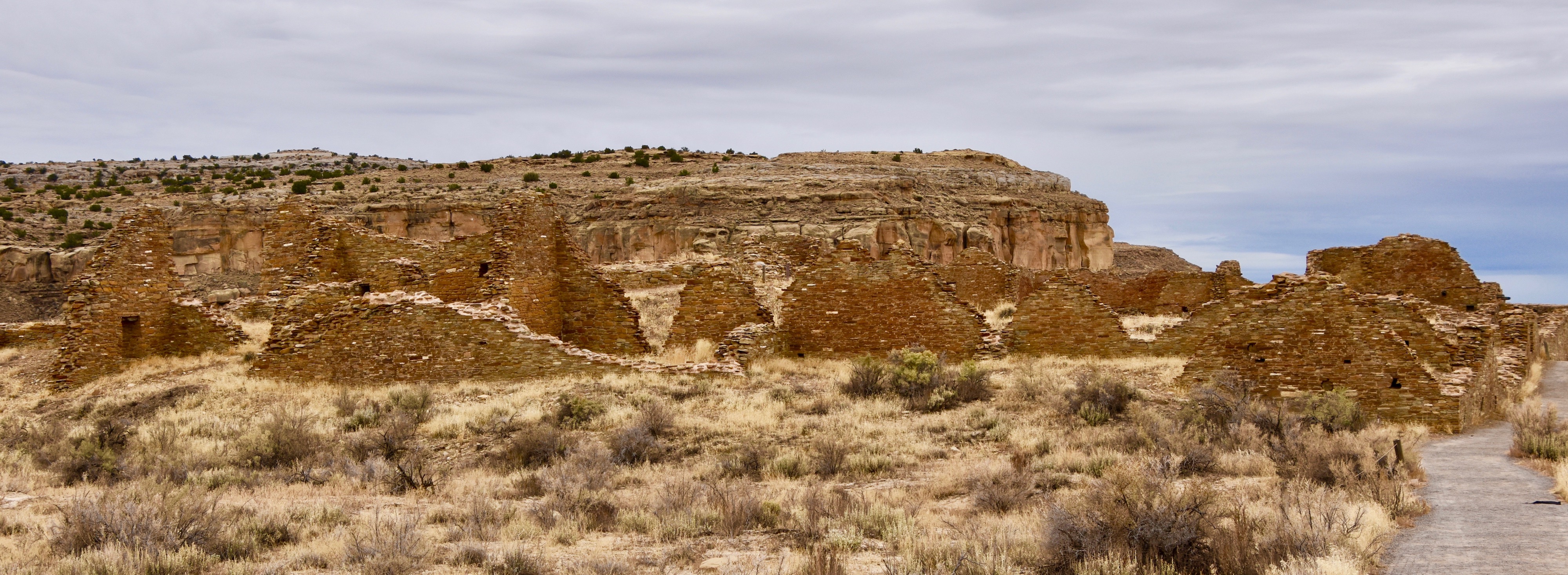
We had a long way to go before we slept so we said our goodbyes to this amazing place, glad that after many years of hoping, we had finally seen it and so should you.

